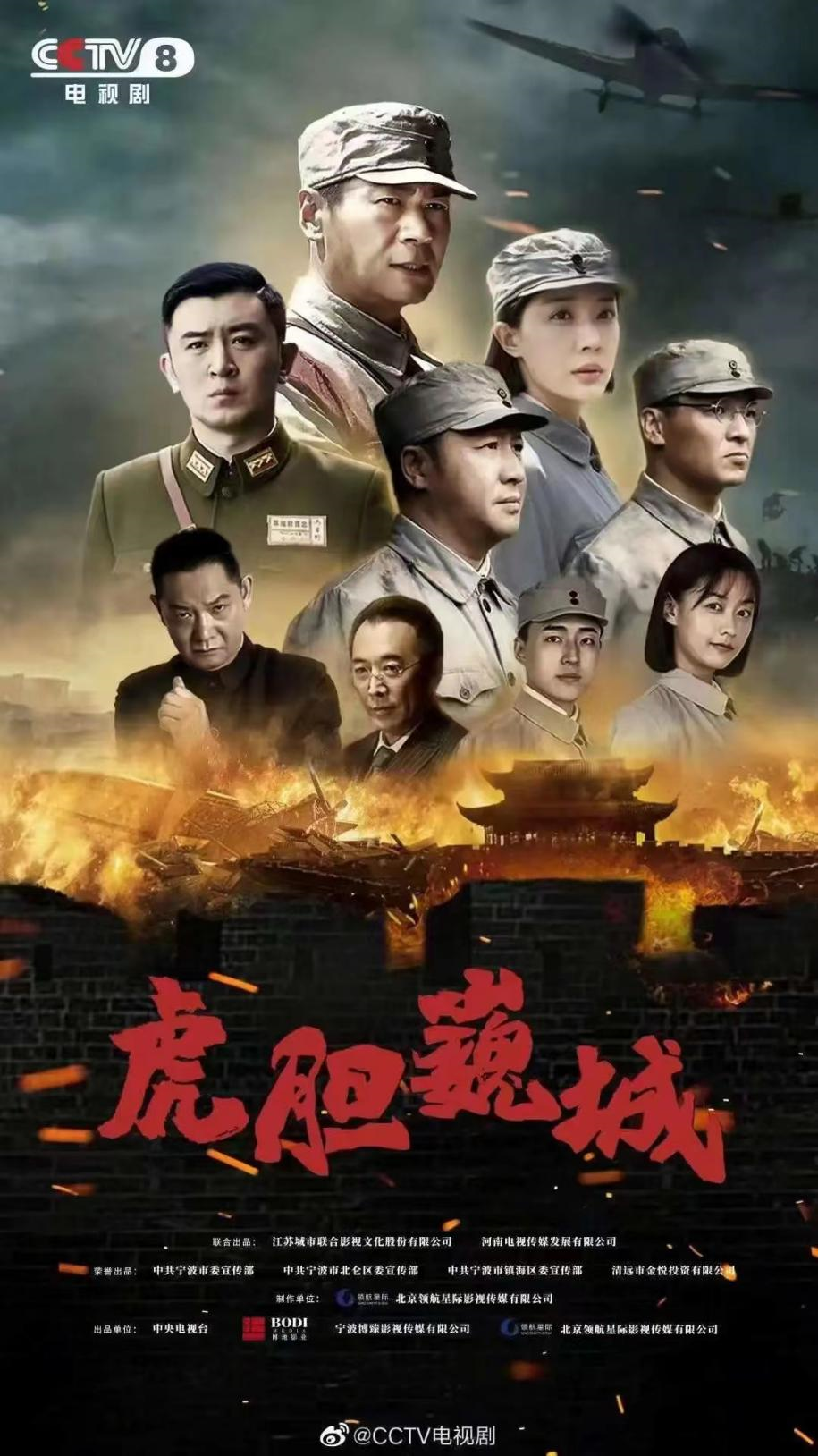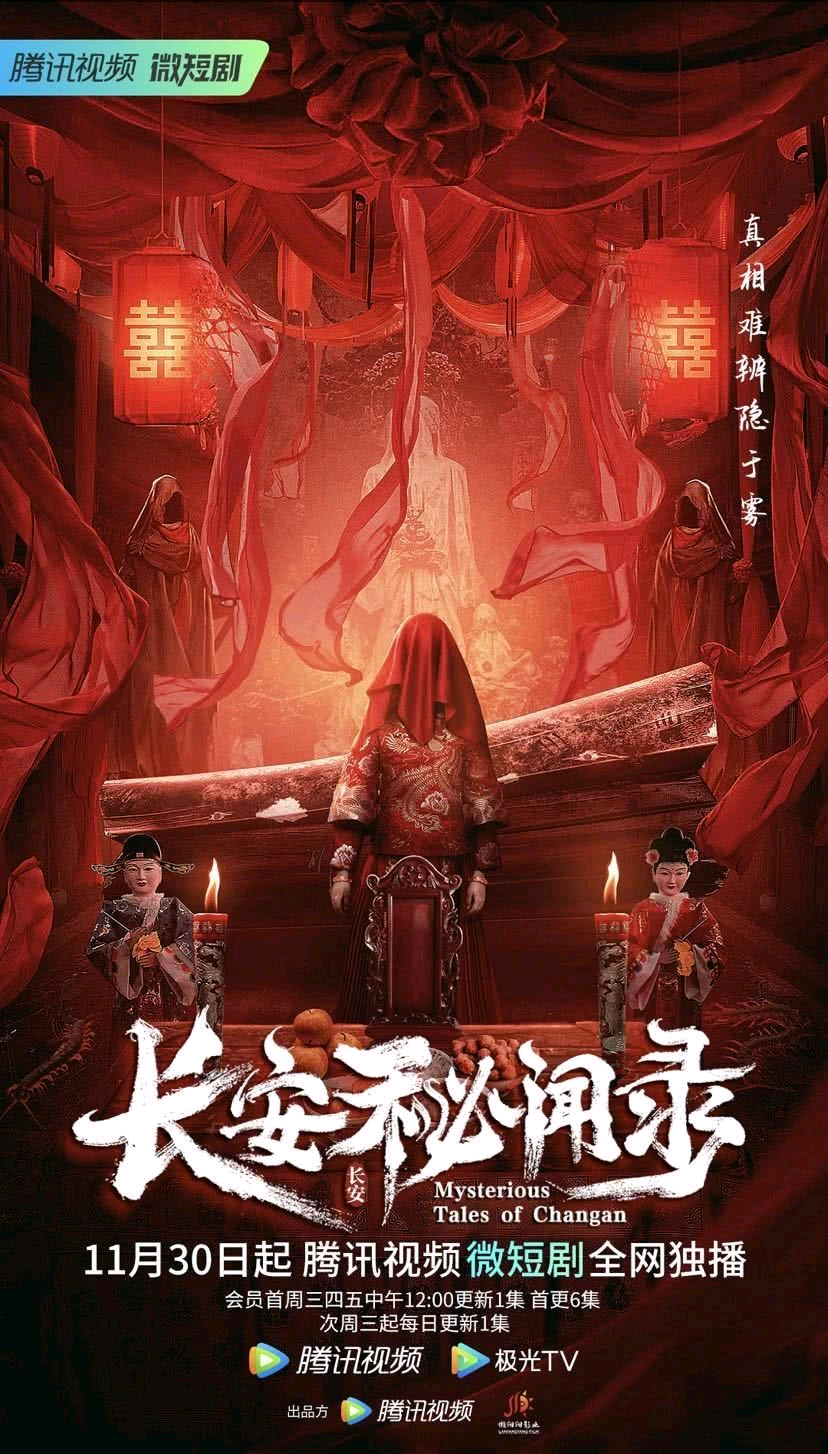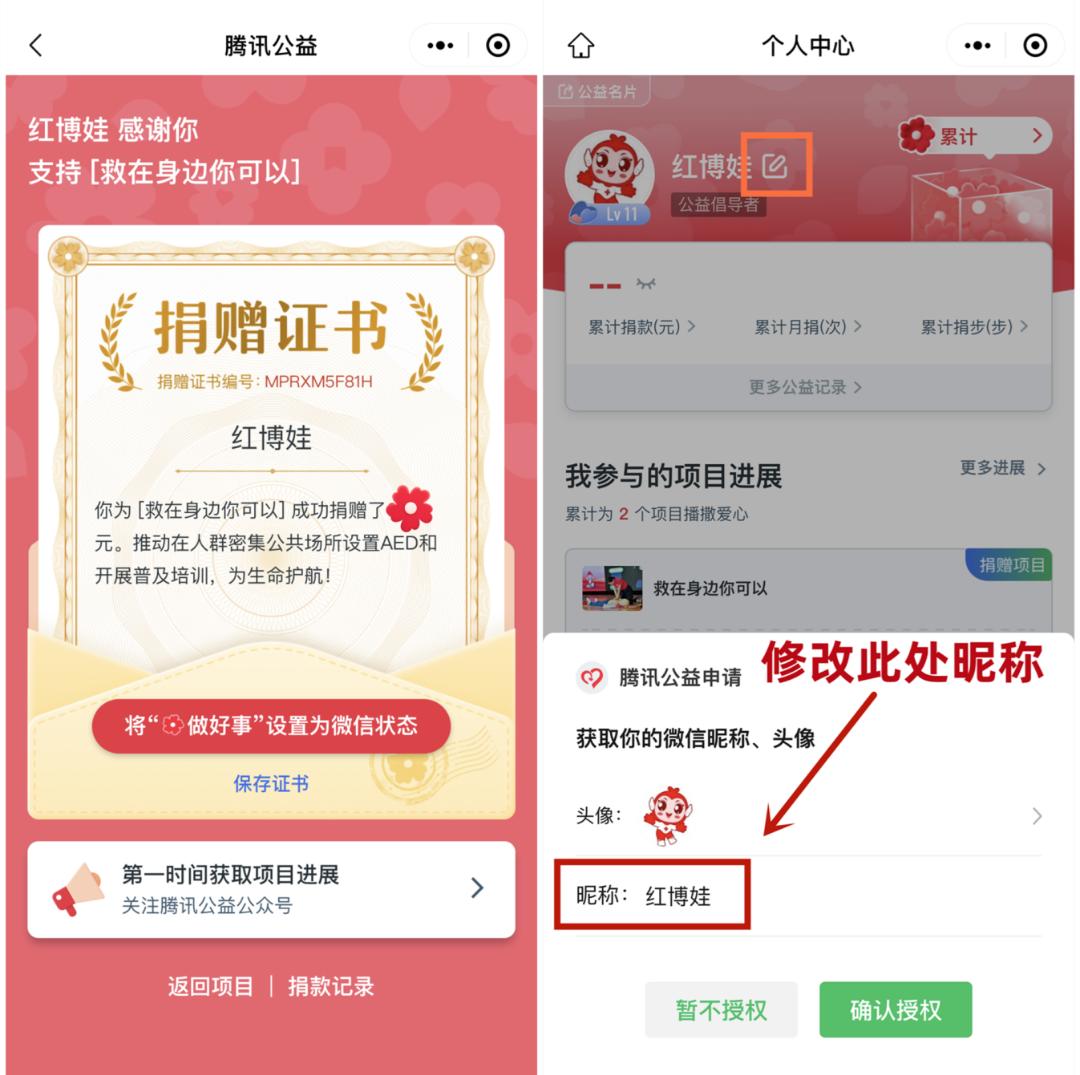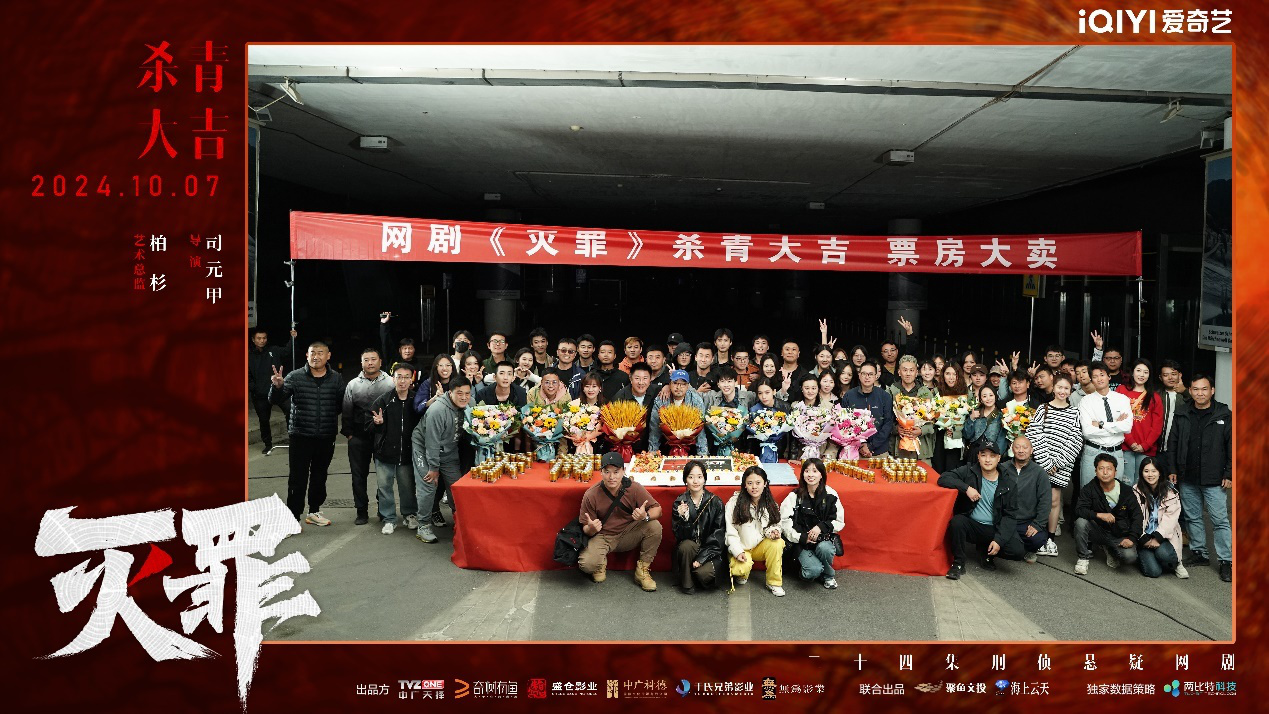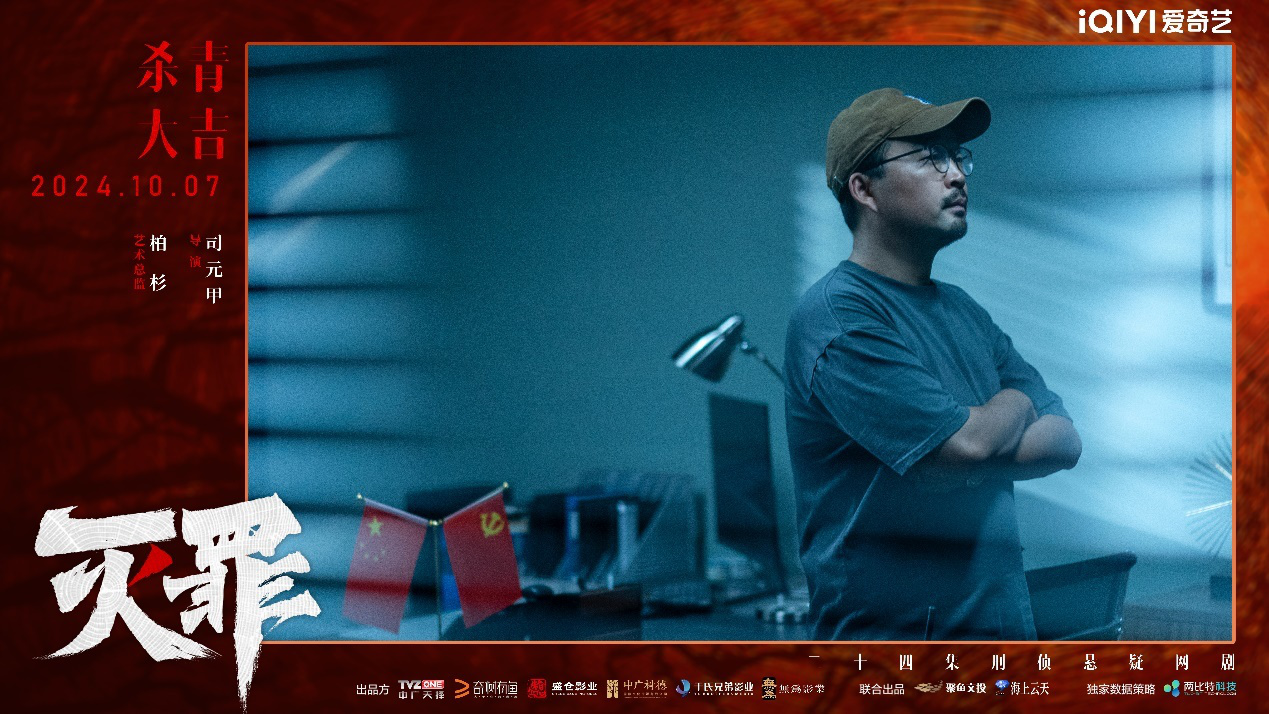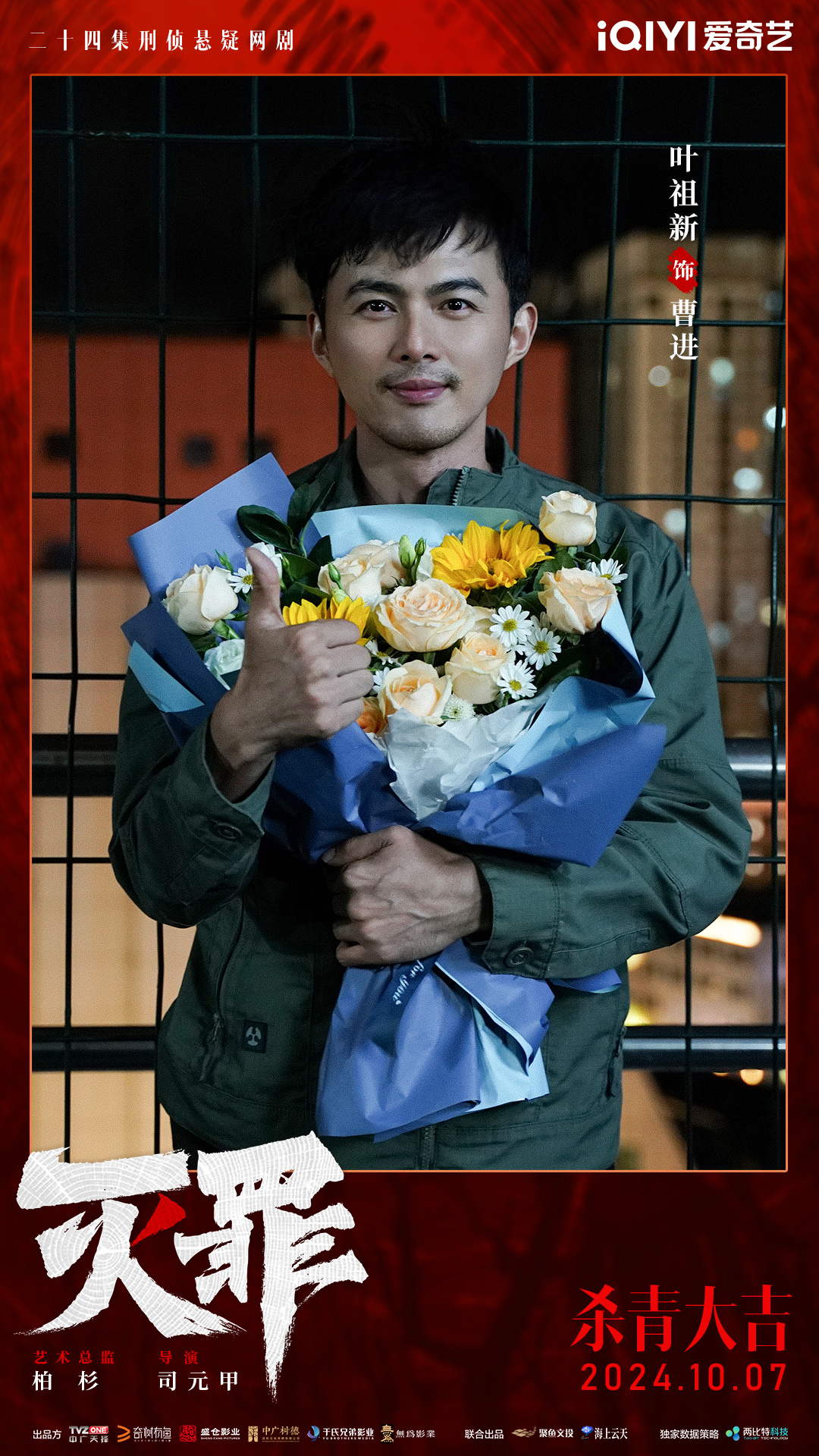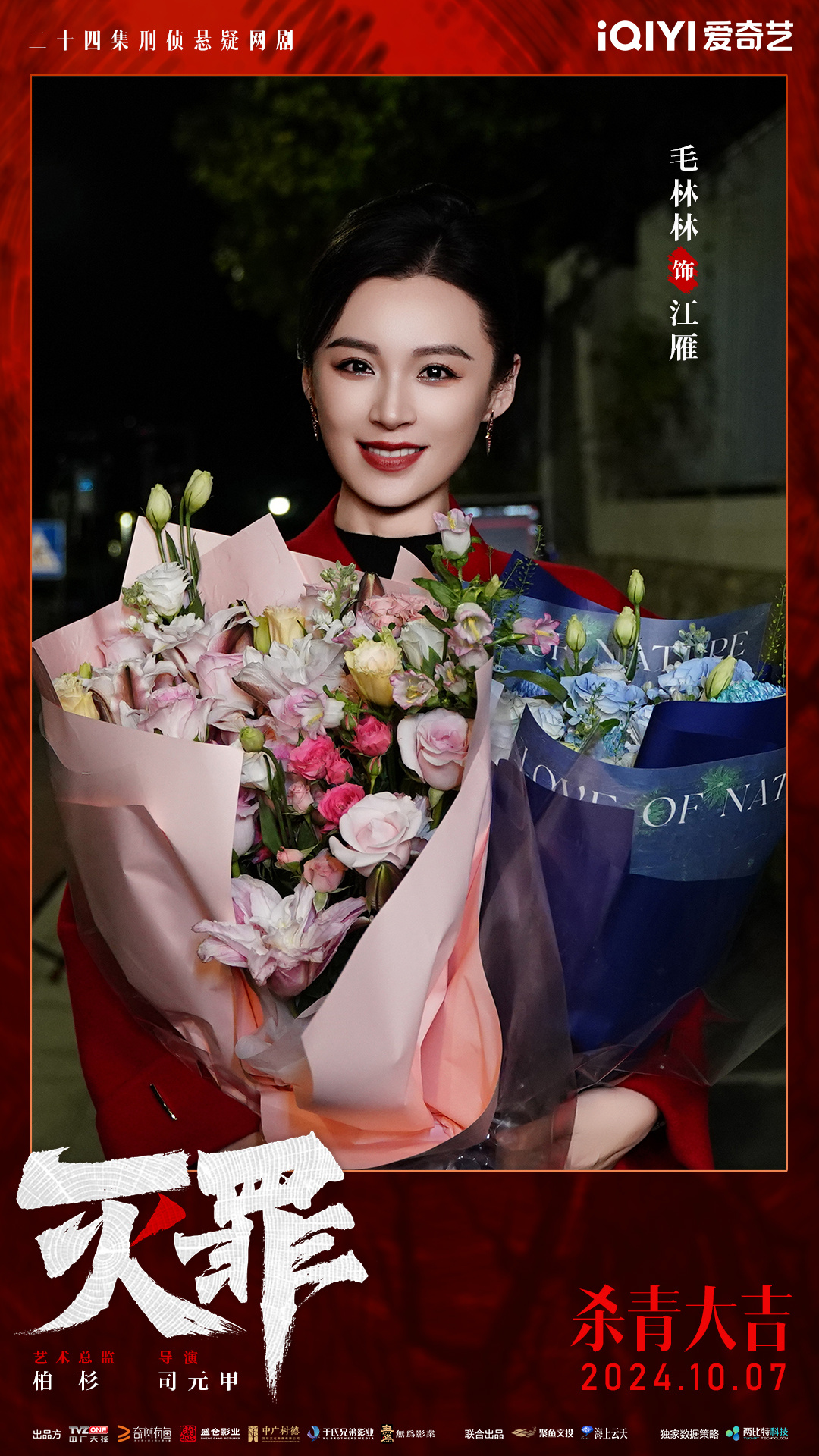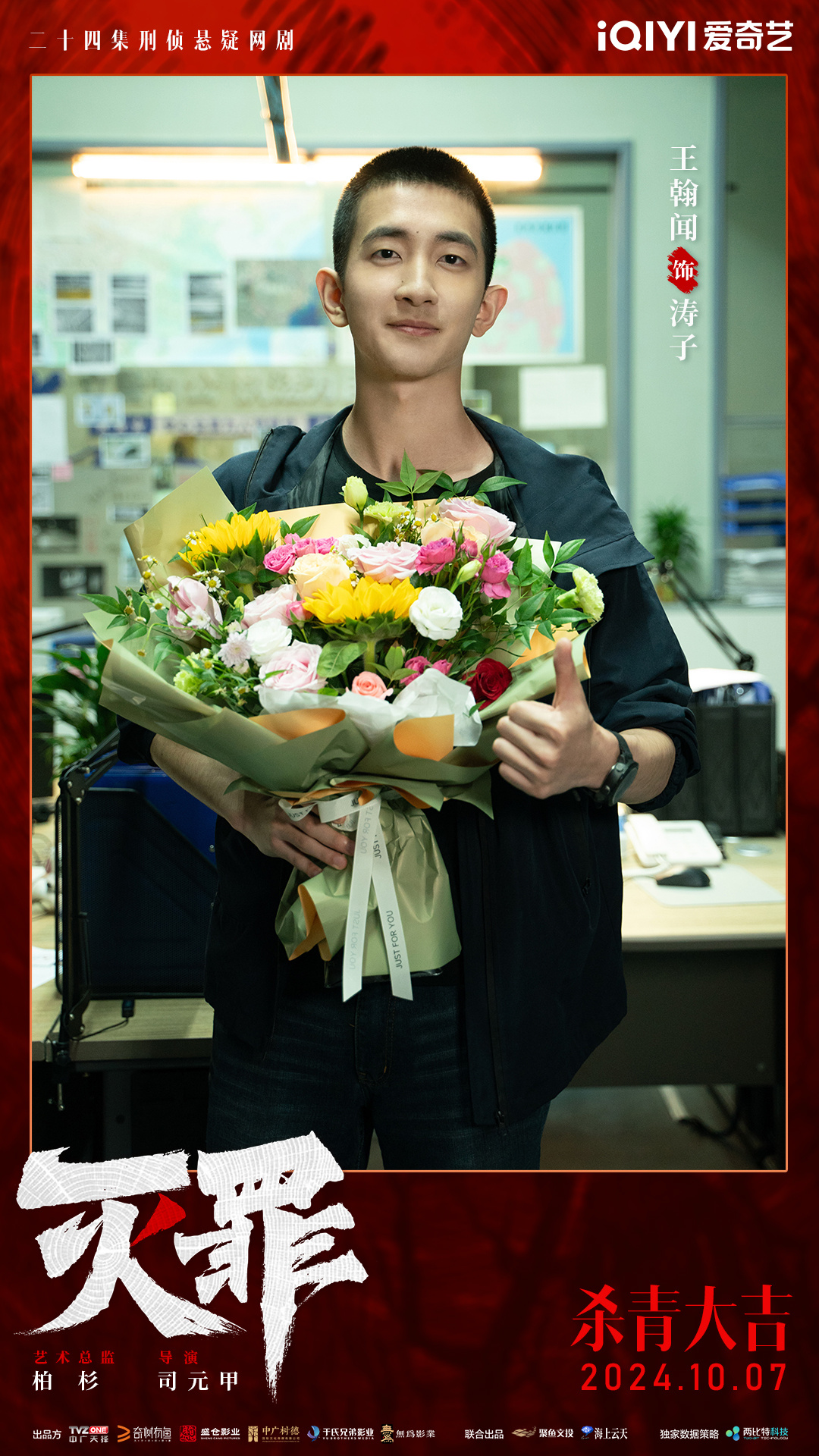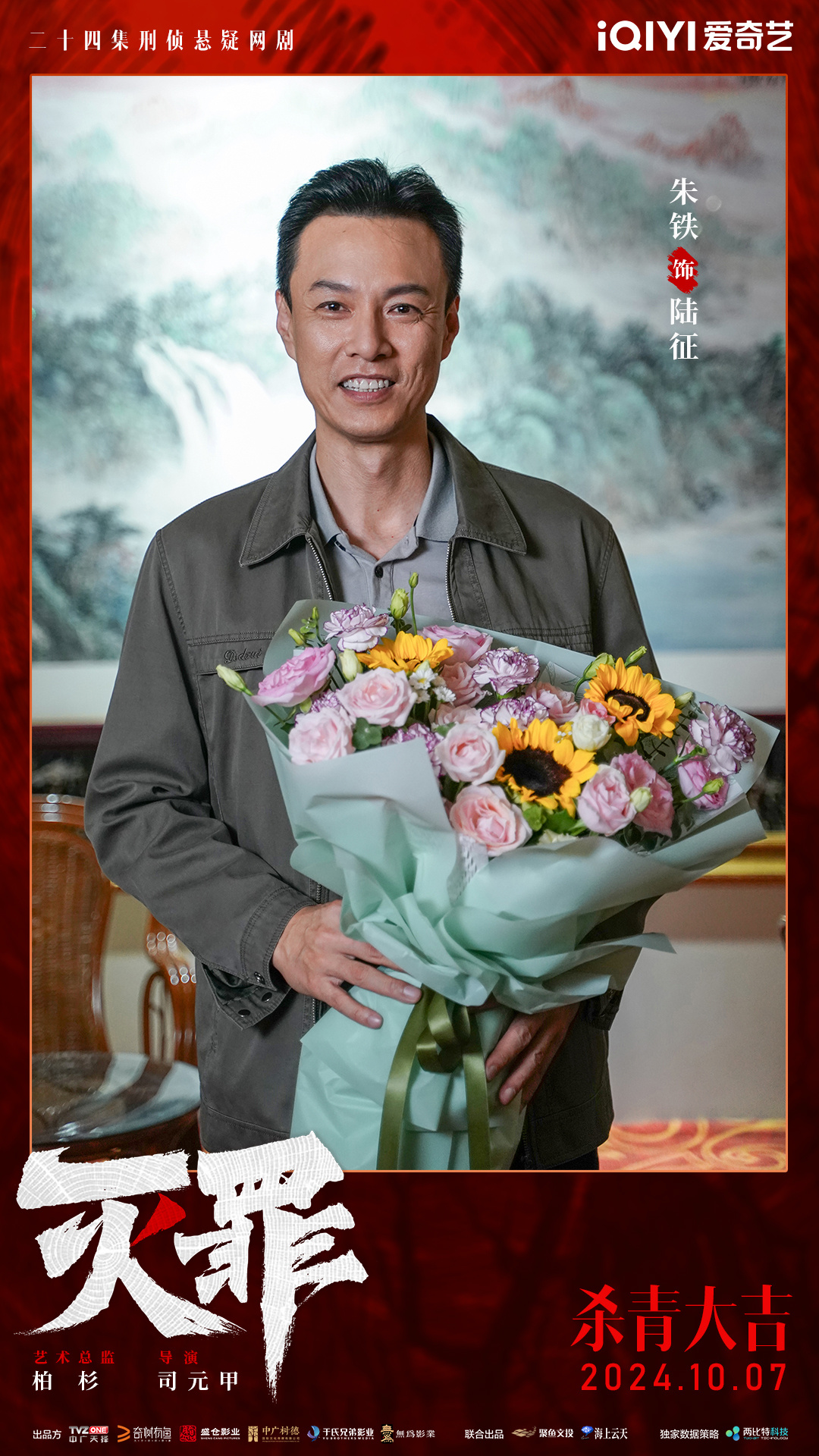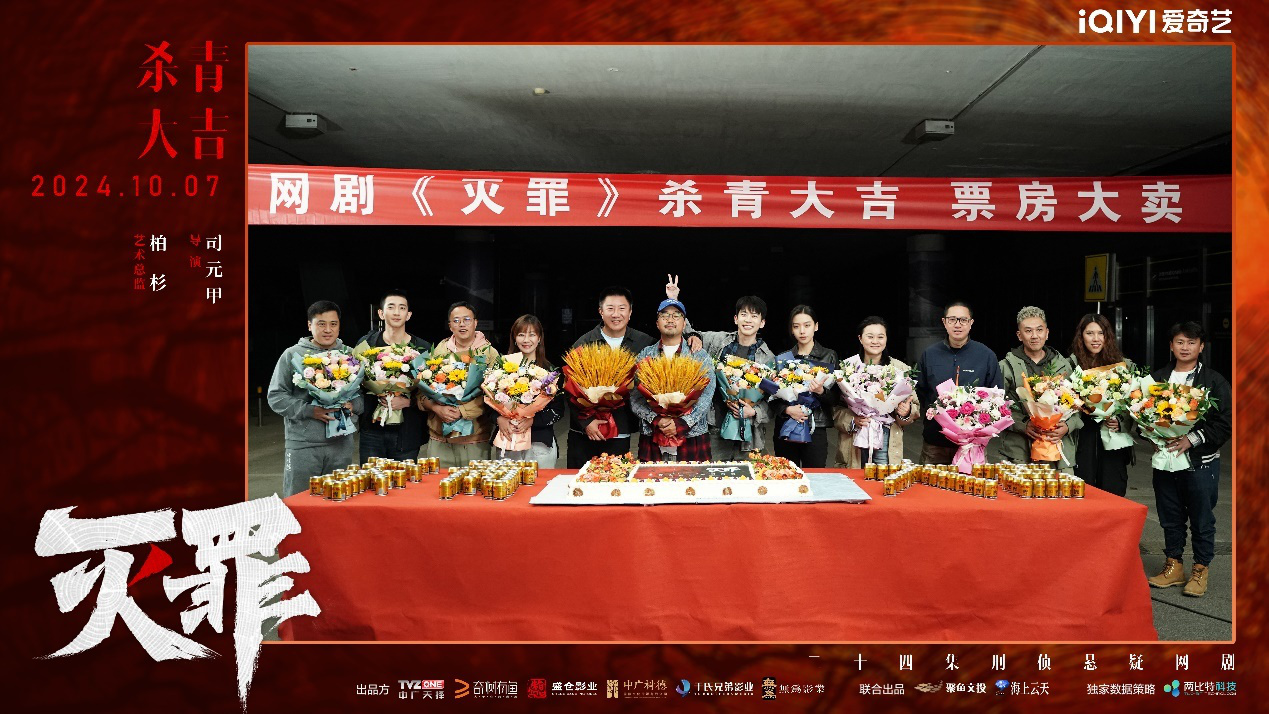Xinhua News Agency, Beijing, April 6-the State Council Press Office released a white paper entitled "China Practice of Human Poverty Reduction" on April 6. The full text is as follows:
China’s Practice of Human Poverty Reduction
(April 2021)
People’s Republic of China (PRC)
the State Council Information Office
catalogue
foreword
I. the Communist Party of China (CPC)’s solemn commitment
(1) the Communist Party of China (CPC) led the people to win the revolutionary victory and establish a new China, which opened a new course of realizing the prosperity of the country and the prosperity of the people.
(B) Reform and opening up have greatly promoted the development of China, and the process of poverty reduction in China has advanced rapidly.
(3) China’s development has entered a new era, and China’s poverty reduction has entered a new historical stage of poverty alleviation.
Second, the new era has achieved a comprehensive victory in getting rid of poverty.
(A) the living standards of the poor have improved significantly.
(2) The backward appearance of poverty-stricken areas has fundamentally changed.
(3) The spirit of the people out of poverty has taken on a new look.
(4) Effective protection of the survival and development rights of groups with special difficulties.
(E) The ability of grassroots governance in poverty-stricken areas has been significantly improved.
Third, implement the strategy of precise poverty alleviation
(A) accurate identification, filing card, to solve the problem of "who to support"
(2) Strengthen leadership and build a strong team to solve the problem of "who will help"
(3) Differentiate categories and make targeted policies to solve the problem of "how to help"
(four) strict standards, orderly exit, to solve the problem of "how to retreat".
(5) Follow-up monitoring, prevent returning to poverty, and solve the problem of "how to stabilize"
Fourth, explore new paths for human poverty reduction
(A) adhere to the people as the center
(2) Put poverty reduction in a prominent position in governing the country.
(3) Eliminating poverty through development.
(D) Promoting the process of poverty reduction based on reality
(5) Give full play to the main role of the poor.
(6) Gather the strength of all parties to form a strong joint force.
5. Work together to build a community of human destiny for common development without poverty.
(A) China’s poverty reduction and development accelerate the global poverty reduction process.
(2) The international community provides support and assistance to China in poverty reduction.
(C) China actively carried out international exchanges and cooperation in poverty reduction.
Concluding remarks
Appendix: Changes and Adjustment of Poverty Alleviation Standards in China
foreword
Poverty is a chronic disease of human society and a common challenge facing the whole world. Poverty and its accompanying problems, such as hunger, disease and social conflicts, seriously hinder the pursuit of a better life. Eliminating poverty is the dream of mankind, and the history of human development is the history of unremitting struggle against poverty.
China, with a population of 1.4 billion, is the largest developing country in the world, with poor foundation, weak foundation and unbalanced development, and has been plagued by poverty for a long time. The scale, distribution and depth of poverty in China are rare in the world, and the difficulty of poverty control is beyond imagination.
This year marks the centenary of the founding of the Communist Party of China (CPC). Over the past 100 years, the Communist Party of China (CPC) has United and led the people to fight poverty with unswerving and indomitable faith and will. Since the 18th National Congress of the Communist Party of China, under the leadership of the CPC Central Committee with the Supreme Leader as the core, China has organized and implemented an unprecedented, strongest and most populous battle against poverty in human history. On February 25, 2021, General Secretary of the Supreme Leader solemnly declared at the national summary and commendation conference on tackling poverty, that the fight against poverty had achieved an all-round victory and that China had completed the arduous task of eliminating absolute poverty.
China, which accounts for nearly one-fifth of the world’s population, has completely eliminated absolute poverty and achieved the poverty reduction goal of the United Nations Agenda for Sustainable Development in 2030 10 years ahead of schedule, which is not only a landmark event in the history of the development of the Chinese nation, but also a major event in the history of human poverty reduction and even human development, and has made great contributions to the development of global poverty reduction and human development and progress.
Poverty is not destiny takes a hand, and poverty is not invincible. The practice of poverty reduction in China shows that the most important thing in fighting poverty is courage, foresight, responsibility and responsibility. As long as we have firm will and determination and put them into practice, we will be able to move forward towards the bright future of getting rid of poverty and achieving common prosperity.
In order to record the great course of eliminating absolute poverty in China, introduce the exploration and practice of human poverty reduction in China, and share the experience and practice of poverty alleviation in China, this white paper is issued.
I. the Communist Party of China (CPC)’s solemn commitment
The Chinese nation has a long history, hard work and wisdom, and has created a splendid Chinese civilization. The Chinese nation has suffered a lot, and the working people have been in poverty for a long time. For thousands of years, the people of China have been struggling to get rid of poverty. After modern times, under the decadent feudal rule and the invasion of western powers, China became a semi-colonial and semi-feudal society, and hundreds of millions of people were in poverty or even abject poverty. The people of China have always been indomitable and struggling, always dreaming of national prosperity and national rejuvenation, and always dreaming of a happy and beautiful life.
(1) the Communist Party of China (CPC) led the people to win the revolutionary victory and establish a new China, which opened a new course of realizing the prosperity of the country and the prosperity of the people.
In July 1921, the Communist Party of China (CPC) was born. China gave birth to communist party, which was an epoch-making event. From the day of its birth, the Communist Party of China (CPC) took seeking happiness for the people of China and rejuvenation for the Chinese nation as his initial mission, and United and led the people in a long and arduous struggle to create their own better life. The first generation of central collective leadership with Comrade Mao Zedong at the core regarded the peasants’ liberation as the basic issue of the revolution, led the people to carry out the agrarian revolution and implement "land to the tiller", overthrew the reactionary rule of imperialism, feudalism and bureaucratic capitalism, won the victory of the new-democratic revolution, established a new China, ended the long history of oppression and exploitation of the people of China, ended the situation of frequent wars and divisions in the country, and realized national independence and people’s liberation.
On October 1st, 1949, People’s Republic of China (PRC) was founded, and the people of China stood up and became masters of their own affairs, truly becoming the masters of their new country and society. Faced with the difficult situation of poverty and poverty, the Communist Party of China (CPC) United and led the people to work hard and strive for strength and rebuild the mountains and rivers. The vigorous land reform was carried out throughout the country, and the feudal land system that lasted for more than 2,000 years was abolished, eliminating the main institutional factors that caused farmers’ poverty. The socialist transformation of agriculture, handicrafts and capitalist industry and commerce and the establishment of a basic socialist system have provided the most basic institutional guarantee for fundamentally solving the poverty problem. Carry out large-scale socialist construction, establish an independent and relatively complete industrial system and national economic system, vigorously develop the collective economy, and vigorously develop farmland water conservancy. Run rural education and cooperative medical care, and explore the establishment of a rural primary social security system based on the collective economy, with the "five guarantees" system and the relief of poor groups as the main body. Socialist construction is advancing in twists and turns, people’s material life and cultural level are gradually improved, and the basic living needs of China people, especially farmers, who account for nearly a quarter of the world’s population, have been initially met.
(2) Reform and opening up have greatly promoted the development of China, and the process of poverty reduction in China has accelerated.
In December 1978, the Third Plenary Session of the Eleventh Central Committee was held in the Central Committee of the Communist Party of China, which opened a new era of reform, opening up and socialist modernization in China. Reform and opening up is another great revolution in the history of the development of Chinese people and the Chinese nation, which has injected a strong impetus for China’s innovation and development. With the rapid economic and social development in China, the process of poverty reduction in China has been accelerated, and the number of poor people has been greatly reduced.
In the early days of reform and opening-up, faced with the grim situation of large rural poverty population base and high incidence of poverty in China, the second generation of central leading collective with Comrade Deng Xiaoping as the core made an important conclusion that "poverty is not socialism, but socialism should eliminate poverty", put forward the goal of achieving a well-off life by the end of the 20th century, formulated a "three-step" development strategy, put forward a strategic concept of "two overall situations", and implemented a series of major agricultural and rural reforms. In rural areas, the implementation of the production responsibility system based on household contract responsibility system and the two-tier management system combining unification and separation has straightened out the most basic production relations in rural areas, mobilized farmers’ enthusiasm for production, and quickly reversed the long-term stagnation of agricultural production. Implementing the reform of agricultural products circulation system and vigorously developing township enterprises have promoted the overall income level in rural areas. Set up special poverty alleviation institutions, determine poverty alleviation standards, key areas and poverty-stricken counties, and start the implementation of the "Three Wests" ④ agricultural construction. Through a series of major measures, rural productive forces have been liberated, rural vitality has been released, rural economic development has been promoted, farmers’ income has been increased and ideas have been updated, and poverty alleviation and development in China has entered a new historical period.
In the early 1990s, while the rural poverty problem was greatly alleviated, the poverty problem showed new features such as stratification, fragmentation and differentiation from the universal distribution, and the uneven development among regions became prominent. The third generation of central collective leadership with Comrade Jiang Zemin at the core has formulated a new "three-step" development strategy, put forward the goal of building a well-off society in an all-round way, and continued to promote large-scale national action to help the poor and develop. In 1994, the State Council City, China issued the "National Poverty Alleviation Plan for the Seventh Five-Year Plan (1994-2000)", which was the first national poverty alleviation and development work program with clear objectives, clear targets, clear measures and clear deadlines in the history of new China. The Eighth Seven-Year Plan proposes that from 1994 to 2000, it will take about seven years to basically solve the problem of food and clothing for the 80 million poor people in rural areas at that time. In 1996, the Central Committee of the Communist Party of China held a conference on poverty alleviation and development, which further clarified that the goal of basically solving the problem of food and clothing for the poor people by the end of the 20th century would never waver, and determined the basic policy of transforming relief-oriented poverty alleviation into development-oriented poverty alleviation. In 1999, the Central Committee of the Communist Party of China held a conference on poverty alleviation and development to make arrangements for winning the Eighth Seven-Year Plan. In 2001, the Central Committee of the Communist Party of China held a conference on poverty alleviation and development, and the State Council, China issued the Outline of Rural Poverty Alleviation and Development in China (2001-2010). On the basis of significant progress, China’s poverty alleviation and development continued to advance in depth.According to the poverty alleviation standards at that time, by the end of 2000, the number of poor people in rural areas in China had decreased to 32.09 million, and the incidence of poverty had decreased to 3.5%.
In the 21st century, the Central Committee of the Communist Party of China, with Comrade Hu Jintao as the general secretary, insisted on Scientific Outlook on Development to build a harmonious socialist society, put forward the goal of building a well-off society in an all-round way, promoted the construction of a new socialist countryside, and formulated and implemented a series of new policies and measures for poverty alleviation and development. Major adjustments have been made to the focus and target of poverty alleviation work, with the central and western regions as the key areas of poverty alleviation work. On the basis of 592 national key poverty alleviation counties, 150,000 poor villages have been selected as poverty alleviation targets, and participatory "whole village promotion" has been implemented to help the poor. Vigorously promote industrial poverty alleviation and labor training transfer, and actively carry out ex situ relocation poverty alleviation and ecological migration. We will implement national regional development strategies, such as the large-scale development of the western region, the revitalization of the old industrial bases in Northeast China, and the rise of the central region, so as to promote the coordinated development of regions and urban and rural areas. Abolishing the agricultural tax and establishing a series of rural social security systems such as the new rural cooperative medical system have fundamentally changed the heavy burden on farmers. In 2011, the Central Committee of the Communist Party of China held a conference on poverty alleviation and development, and the Central Committee of the Communist Party of China and the State Council issued the Outline of Rural Poverty Alleviation and Development in China (2011-2020). China’s poverty alleviation and development has shifted from the stage of solving food and clothing as its main task to a new stage of consolidating the achievements of food and clothing, speeding up poverty alleviation, improving the ecological environment, improving development capacity and narrowing the development gap. According to the poverty alleviation standards at that time, by the end of 2010, the number of poor people in rural areas in China had decreased to 26.88 million, and the incidence of poverty had dropped to 2.8%. In 2011, China raised the poverty alleviation standard to 2,300 yuan.Under the new poverty alleviation standard, the poverty population in China is 122 million.
(3) China’s development has entered a new era, and China’s poverty reduction has entered a new historical stage of poverty alleviation.
Since the 18th National Congress of the Communist Party of China, the development of China has entered a new era, and building a well-off society in an all-round way and achieving the goal of the first century have entered a critical stage. The rapid economic and social development, the obvious enhancement of comprehensive national strength, the more perfect social security system, and the accelerated modernization of the national governance system and governance capacity have laid a solid human, financial and material foundation for the development of poverty reduction and provided strong institutional support. At the same time, China is still facing a severe poverty situation, which is characterized by poverty among the poor and firmness among the strong. Poverty reduction has entered the sprint stage of gnawing hard bones, attacking hard and pulling out villages. It is difficult to complete the task by adopting conventional ideas and methods and advancing step by step. We must achieve the goal of tackling poverty with greater determination, clearer ideas, more precise measures and extraordinary efforts.
The Central Committee of the Communist Party of China, with the Supreme Leader as the core, took the people’s yearning for a better life as the goal, put forward the Chinese dream of realizing the great rejuvenation of the Chinese nation, promoted the decisive victory to build a well-off society in an all-round way, took all the poor people out of poverty as the bottom line task and symbolic index to build a well-off society in an all-round way and realize the goal of the first century, and incorporated poverty alleviation into the overall layout of "five in one" and the strategic layout of "four comprehensive". It is clear that by 2020, under the current standards, the rural poor will be lifted out of poverty, all poverty-stricken counties will be stripped of their hats, and the overall poverty in the region will be solved, and the whole party, the whole country and the whole society will be brought together to launch a tough battle against poverty. General Secretary of the Supreme Leader always cares about poverty-stricken areas and people in difficulty, regards poverty alleviation as an important part of governing the country, spends the most energy, puts forward a series of important thoughts and important expositions, and makes a series of major decisions and arrangements. In 2012, the 18th National Congress of the Communist Party of China put forward the goal of building a well-off society in an all-round way. Shortly after the 18th National Congress, the General Secretary of the Supreme Leader pointed out that "well-off society is not well-off, the key depends on fellow villagers, and the key lies in whether poor fellow villagers can get rid of poverty", emphasizing that "a poor area and a poor people must not be left behind", which opened the prelude to poverty alleviation in the new era. In 2013, when General Secretary of the Supreme Leader visited Shibadong Village, Huayuan County, Hunan Province, he first put forward the concept of "seeking truth from facts, adapting to local conditions, guiding by classification, and helping the poor accurately".In 2014, General Secretary of the Supreme Leader pointed out during the deliberation of the Guizhou delegation at the Second Session of the 12th National People’s Congress that "seeing the real poverty, helping the real poverty and helping the poor". In 2015, when General Secretary of the Supreme Leader attended the Central Poverty Alleviation and Development Work Conference, he pointed out that "it is necessary to set a goal of" Yu Gong Yi Shan Zhi ",stick to the goal and work hard", which sounded the charge of fighting poverty. In 2017, the General Secretary of the Supreme Leader pointed out in the report of the 19th National Congress of the Communist Party of China that "it is our party’s solemn commitment to let poor people and poverty-stricken areas join the whole country in entering a well-off society in an all-round way" and "resolutely win the battle against poverty", and mobilize the whole party, the whole country and the whole society to gather strength to conquer the fortress of deep poverty and fight a decisive battle against poverty. In 2020, in the face of the sudden epidemic in COVID-19, the General Secretary of the Supreme Leader presided over a symposium on decisive battle to get rid of poverty for redeployment and mobilization, pointing out that all rural poor people must be lifted out of poverty as scheduled, without any retreat and flexibility. This is a tough battle. In the end, we must tighten this string, and we must not pause, be careless, or relax. "We require the whole party and the whole country to do a good job of" adding test questions "and finishing the battle with greater determination and strength, and March with confidence towards the final victory of poverty alleviation.
General Secretary of the Supreme Leader personally commanded, deployed and supervised the war, attended the Central Poverty Alleviation and Development Work Conference, presided over the Central Poverty Alleviation Work Symposium for seven times, investigated the poverty alleviation work for more than 50 times, examined and approved the effectiveness assessment results of poverty alleviation for five consecutive years, attended important activities or made important instructions during the National Poverty Alleviation Day for seven consecutive years, and emphasized poverty alleviation in the New Year message for seven consecutive years. Every year, during the two sessions of the National People’s Congress, the delegation and the deputies discussed the poverty alleviation plan, and wrote back many times to encourage grassroots cadres and masses to join the poverty alleviation cause. The General Secretary of the Supreme Leader traveled to 14 concentrated contiguous poverty-stricken areas in China, inspected more than 20 poverty-stricken villages, went deep into poor families to visit the poor and ask questions, listened to the opinions and suggestions of the poor people, and understood the needs of poverty alleviation, which greatly encouraged the confidence and determination of the poor people to get rid of poverty and become rich. On February 25th, 2021, General Secretary of the Supreme Leader solemnly declared that China had won a comprehensive victory in the fight against poverty, completed the arduous task of eliminating absolute poverty, and created another miracle in history.
Looking back on the arduous course of the Communist Party of China (CPC) leading the people to eliminate absolute poverty is extremely extraordinary and difficult. Over the past 100 years, the Communist Party of China (CPC) has always adhered to its original mission, shouldered its responsibilities to the people, fulfilled its promises to the people, and made great sacrifices to achieve national independence, people’s liberation, national prosperity and people’s prosperity, winning the support and trust of the people. Over the past 100 years, under the leadership of the Communist Party of China (CPC), the people of China have been striving for self-improvement, working hard, relying on their own hands, paying unimaginable hard work and sweat, getting rid of absolute poverty and embarking on the broad road of overall well-off and common prosperity. Over the past 100 years, under the leadership of the Communist Party of China (CPC), China has ushered in a great leap from standing up, becoming rich and becoming strong. The people’s right to subsistence and development has been fully guaranteed, and social fairness and justice have been vigorously demonstrated, laying a solid foundation for better realizing people’s all-round development.
Second, the new era has achieved a comprehensive victory in getting rid of poverty.
After eight years of continuous struggle since the 18th National Congress of the Communist Party of China, by the end of 2020, China has achieved the goal of tackling poverty in the new era as scheduled. Under the current standards, 98.99 million rural poor people have all been lifted out of poverty (Figure 1), 832 poverty-stricken counties have all taken off their hats (Figure 2), and 128,000 poverty-stricken villages have all been listed, thus solving the overall regional poverty and completing the arduous task of eliminating absolute poverty.
The fight against poverty has changed China’s rural areas in a historic and all-round way, and it is another great revolution in China’s rural areas. It has profoundly changed the backward appearance of poverty-stricken areas, effectively promoted the overall development of China’s rural areas, filled the most prominent shortcomings of building a well-off society in an all-round way, and laid a solid foundation for building a socialist modern country in an all-round way and realizing the goal of the second century. The battle against poverty was completely won, and the Chinese nation completely eliminated absolute poverty for the first time in thousands of years of development history, thus realizing the Millennium dream and long-cherished wish of the people of China.

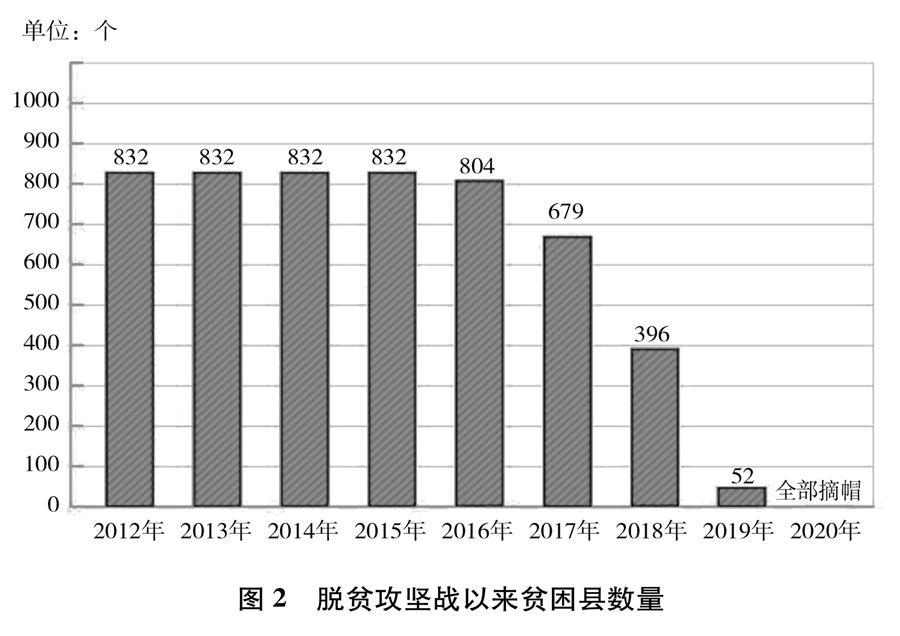
(A) the living standards of the poor have improved significantly.
After the tough fight against poverty, the income and welfare level of the poor people have been greatly improved, and the "two guarantees and three guarantees" have been fully realized, and the conditions of education, medical care, housing and drinking water have been significantly improved, which not only meets the basic survival needs, but also lays the foundation for subsequent development. The sunshine of poverty alleviation shines on every corner, and the lives of poor people have undergone tremendous changes.
The income level of the poor has continued to rise (Figure 3). The per capita disposable income of rural residents in poverty-stricken areas increased from 6,079 yuan in 2013 to 12,588 yuan in 2020, with an average annual growth rate of 11.6%. The growth rate continued to be faster than that of rural areas nationwide, and the growth rate was 2.3 percentage points higher than that of rural areas nationwide. The proportion of wage income and operational income of the poor population has increased year by year, while the proportion of transfer income has decreased year by year, and the ability to increase income independently and get rid of poverty has steadily improved. Significant progress has been made in poverty alleviation in ethnic minority areas. From 2016 to 2020, the number of poor people in Inner Mongolia Autonomous Region, Guangxi Zhuang Autonomous Region, Xizang Autonomous Region, Ningxia Hui Autonomous Region, Xinjiang Uygur Autonomous Region and Guizhou, Yunnan and Qinghai provinces has decreased by 15.6 million. All the 28 ethnic groups with less population have been lifted out of poverty. After the founding of New China, some people entered the socialist society "through the nation" in one step, and achieved the second historic leap from poverty and backwardness to a well-off society in an all-round way.

The "two guarantees and three guarantees" have been fully realized. (8) The general survey of tackling poverty shows that poor households have fully realized that they have no worries about food and clothing, and they are usually full and can eat well, and they have seasonal clothes and warm bedding all year round. The opportunities for poor people to receive education have increased significantly and their level has been continuously improved. The problem of children dropping out of compulsory education in poor rural families has been dynamically cleared. In 2020, the consolidation rate of nine-year compulsory education in poor counties will reach 94.8%. We will continue to improve the three-level medical and health service system in counties and villages, include all the poor people in the triple system of basic medical insurance, serious illness insurance and medical assistance, and implement measures such as centralized treatment for serious illness, contract management for chronic illness, and comprehensive protection for serious illness. More than 99.9% of the poor people will participate in basic medical insurance, so as to fully realize that the poor people have a place to see a doctor, a doctor and a medical insurance system, and effectively solve the problems of difficult and expensive medical treatment. Implement the renovation of dilapidated houses in rural areas, and the poor will fully realize the housing security (column 1). Implement rural drinking water safety and consolidation and upgrading projects to solve the drinking water safety problems of 28.89 million poor people, and all the drinking water quantity and quality meet the standards, benefiting 382 million rural people; The penetration rate of tap water in poor areas will increase from 70% in 2015 to 83% in 2020.
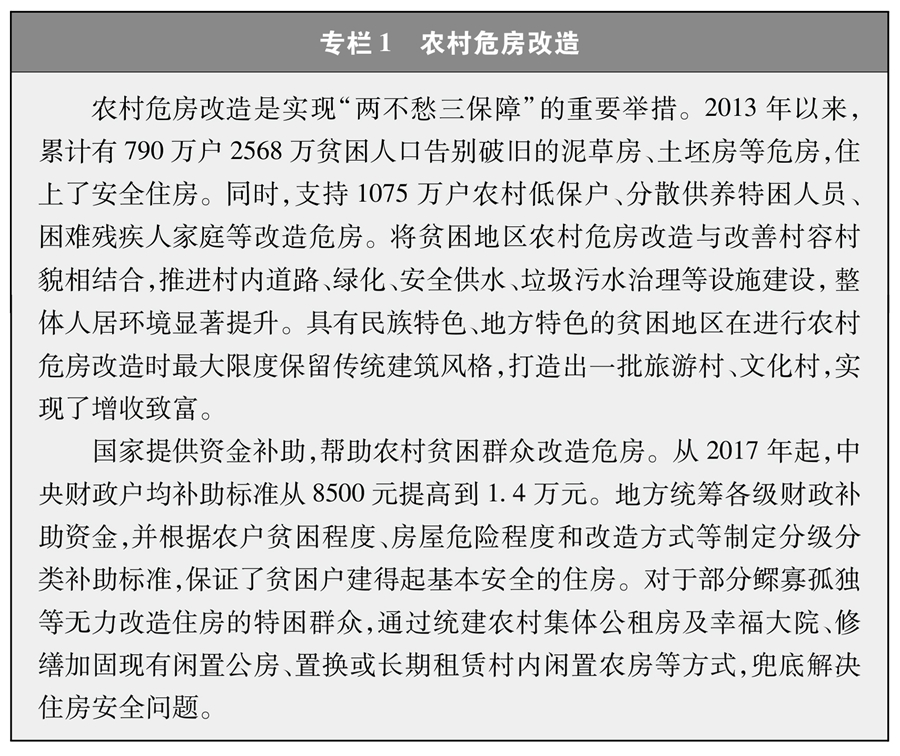
(2) The backward appearance of poverty-stricken areas has fundamentally changed.
For a long time, poor areas have weak infrastructure, lack of public services and backward economic and social development. The fight against poverty has not only lifted all the rural poor out of poverty, but also made great strides in the economic and social development of poverty-stricken areas, and the overall appearance has undergone historic changes.
The infrastructure has improved significantly. It is difficult to travel, use electricity, use water and communicate, which have long been the bottleneck restricting the development of poor areas. Taking infrastructure construction as the basic project to get rid of poverty, we concentrated our efforts, increased investment, and made every effort to make up for the shortcomings of infrastructure in poverty-stricken areas and promoted the rapid economic and social development in poverty-stricken areas. Guided by the construction, management, protection and operation of rural roads (referred to as "four good rural roads", column 2), we will actively promote the construction of a safe and convenient transportation network in poverty-stricken areas, which connects the outside with the inside, connects the villages with the countryside, and takes buses to the villages. By the end of 2020, 1.1 million kilometers of roads have been newly rebuilt and 35,000 kilometers of railways have been added in poverty-stricken areas across the country. All towns and villages with conditions in poverty-stricken areas have access to hardened roads, buses and postal roads, and poverty-stricken areas are prosperous and rich because of roads. Efforts have been made to improve the water conservancy infrastructure conditions in poverty-stricken areas. Since 2016, the effective irrigation area of farmland has been increased and improved by 80.29 million mu, and the water supply capacity has been increased by 18.1 billion cubic meters. The ability of water conservancy to support the development of poverty-stricken areas has been significantly enhanced. Greatly improve the power consumption conditions in poverty-stricken areas, implement special power grid projects such as power construction in areas without electricity, rural power grid renovation and upgrading, backbone power grid and transmission channel construction, extend the power grid to more remote areas, basically achieve full coverage of stable and reliable power supply services in rural areas, and significantly improve power supply capacity and service level (Box 3). Strengthen the construction of communication facilities in poverty-stricken areas, and the proportion of optical fiber and 4G in poor villages exceeds 98%.Distance education has been accelerated to schools in poverty-stricken areas, telemedicine and e-commerce have covered all poverty-stricken counties, and information construction in poverty-stricken areas has achieved leap-forward development. The great improvement of infrastructure has fundamentally solved the problem of poverty alleviation in poverty-stricken areas, unblocked the flow of people, logistics, knowledge and information between poverty-stricken areas and the outside world, and provided strong hardware support for the development of poverty-stricken areas.

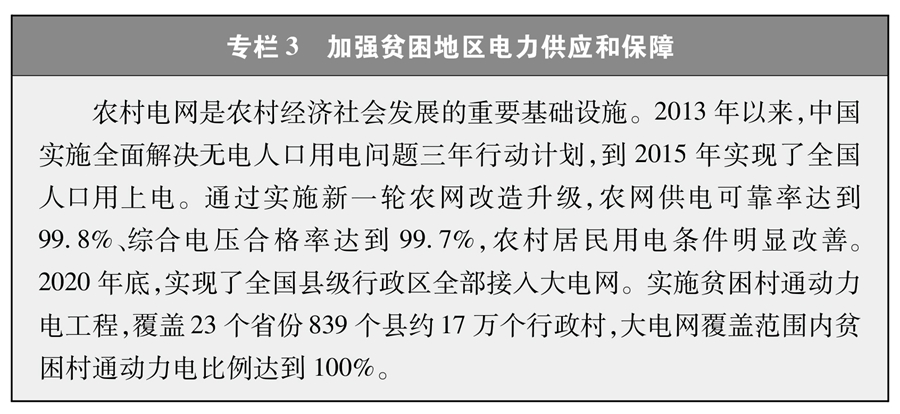
The level of basic public services has improved significantly. On the basis of solving the problems of food and clothing, housing and other basic public services in poverty-stricken areas, we will vigorously improve the level of education, medical care, culture, social security and other basic public services, so as to realize the poor people’s education, medical care, old age and weak support, and lay a solid foundation for the development of poverty-stricken areas and accumulate stamina. Since 2013, a total of 108,000 schools with weak compulsory education in poverty-stricken areas have been transformed, so that all school-age children in poverty-stricken areas can be in kindergartens and primary schools in their villages. The level of public cultural services in poverty-stricken areas has been continuously improved. By the end of 2020, the proportion of grassroots cultural centers in 22 provinces in the central and western regions has reached 99.48%, basically achieving full coverage of village-level cultural facilities; Continue to promote culture to the countryside, and the poor people also have a colorful amateur cultural life. The medical conditions in poverty-stricken areas have been significantly improved, eliminating the "blank spots" in rural medical and health institutions and personnel at two levels. 98% of poverty-stricken counties have at least one hospital at or above the second level. The median number of diseases admitted by county-level hospitals in poverty-stricken areas has reached 90% of the overall level of county-level hospitals in China. The common and chronic diseases of poor people can basically be treated in time nearby, and more and more serious diseases can be effectively treated in counties. The comprehensive security system has been gradually improved, and the rural minimum living standards in poverty-stricken counties have all exceeded the national poverty alleviation standards, and 19.36 million poor people have been included in the rural minimum living standards or special poverty relief and support policies; 60.98 million poor people participated in the basic old-age insurance for urban and rural residents, and basically achieved all the insurance coverage.
Sustained and rapid economic development. Poverty alleviation has greatly released the potential contained in poverty-stricken areas and injected a strong impetus into economic development. The industrial structure has been significantly improved, industries with distinctive advantages have been continuously developed, and new formats and industries such as e-commerce, photovoltaics and tourism have flourished, which has promoted the diversified economic development in poverty-stricken areas, expanded the effective supply of the market, and laid a solid foundation for economic development. The GDP of poverty-stricken areas has maintained rapid growth. Since 2015, the average annual growth rate of per capita general public budget revenue is about 7 percentage points higher than the national average in the same period. The sustained and steady growth of income has stimulated the needs of poor people to improve their quality of life and enrich their spiritual and cultural life, stimulated huge rural consumption, and provided support for promoting the great domestic cycle.
Inheriting and carrying forward excellent culture. Strengthen the protection, inheritance and promotion of traditional culture, characteristic culture and national culture in poverty-stricken areas, and the excellent culture in poverty-stricken areas will flourish. Implement the national traditional craft revitalization project, guide and promote the old revolutionary base areas, ethnic areas, border areas and poverty-stricken areas to protect and develop local excellent traditional skills. Support poverty-stricken areas to dig deep into the characteristic resources of national culture, red culture, local culture and intangible cultural heritage, strengthen protection research, personnel training, display and promotion, and build a characteristic cultural tourism industry. We will carry out activities to keep poverty alleviation marks, establish poverty alleviation files in poor villages, encourage and support the creation of film and television literary works on poverty alleviation, and vividly record the process of getting rid of poverty and becoming rich. The protection and inheritance of excellent culture in poverty-stricken areas not only promoted the poor people to increase their income and get rich, but also continued the context and retained homesickness.
The ecological environment is more beautiful and better. Combining poverty alleviation and development with soil and water conservation, environmental protection and ecological construction, through measures such as ecological poverty alleviation, rural human settlements improvement, and ex situ poverty alleviation and relocation in ecologically fragile areas, the level of ecological protection in poverty-stricken areas has been significantly improved, guarding green mountains and green hills and getting Jinshan Yinshan. Poverty alleviation has not only promoted the "income increase" of poor people, but also promoted the "greening" of poor areas, greatly improved the ecological environment of poor areas, changed the old appearance of the vast rural areas, and continuously improved the level of ecological livability.
Deep poverty areas are poor in poverty and strong in strength. Through tackling poverty, outstanding problems in deep poverty areas such as "three districts and three states" have been fundamentally solved, the level of infrastructure and public services has been significantly improved, the development of characteristic leading industries has been accelerated, the degree of social civilization has been significantly improved, and the overall regional poverty problem has been completely solved (Box 4).
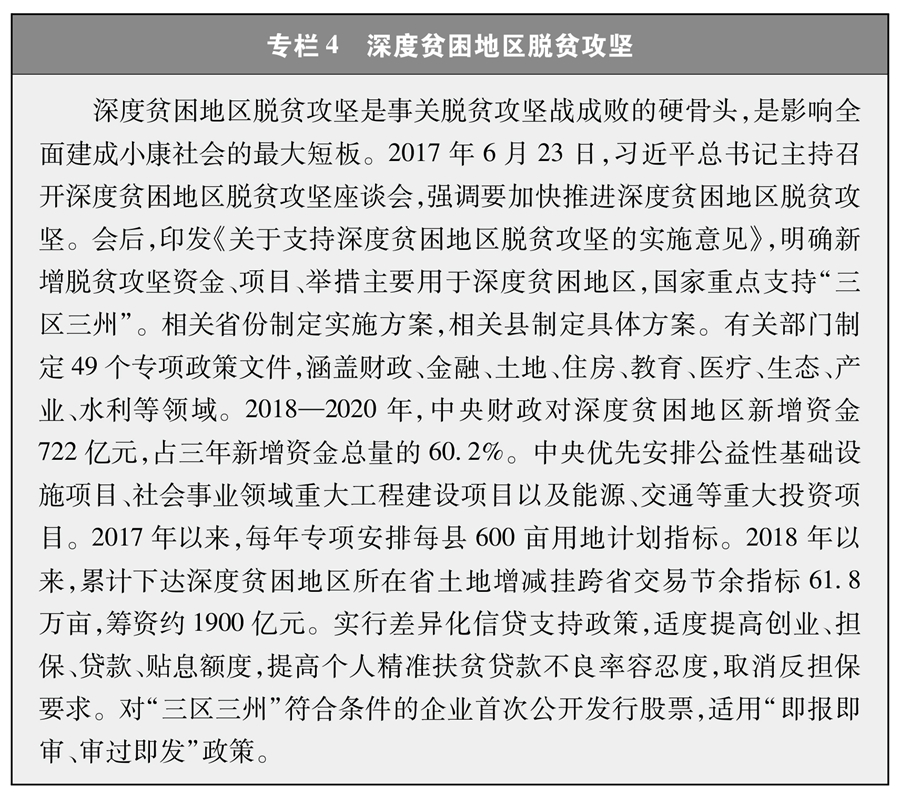
(3) The spirit of the people out of poverty has taken on a new look.
Poverty alleviation is not only a profound material revolution, but also a profound ideological revolution; It has achieved fruitful results both materially and spiritually. The spiritual world of the poor people has been enriched and sublimated in the process of getting rid of poverty, and their confidence has become stronger, their brains have become more vivid and their hearts have become more full, and profound changes have taken place from the inside out.
The enthusiasm for getting rid of poverty and getting rich is high. Poverty alleviation not only broadens the channels for the poor to increase their income and increase their income, but also awakens the poor people’s pursuit of a better life, greatly boosting and remolding their spirit of self-reliance, self-improvement, hard work, diligence, entrepreneurship and Excellence, and enhancing their confidence and momentum in poverty alleviation. "Good days are made", and the poor people are better off and get rid of poverty by their own hard work, forming a strong atmosphere of chasing after me and rushing to a well-off society.
The sense of ownership has improved significantly. Poverty alleviation has built a new platform for poor people to participate in collective affairs. We should make decisions on major village-level issues such as the implementation of poverty alleviation projects and the use of funds, implement "four discussions and two publicity" (10), establish and improve the village supervision mechanism, and promote the system of villagers’ councils and poverty alleviation councils, so that villagers can do "everyone’s affairs are discussed and done by everyone", which expands the discussion and management space for poor people to participate in poverty alleviation, improves their enthusiasm and consciousness in participating in collective affairs, stimulates their enthusiasm for building their hometown, and greatly enhances the cohesion of rural development.
Modern ideas are constantly strengthening. Poverty alleviation has opened the door to the outside world in poor areas. The improvement of transportation infrastructure has opened up the contact between poor areas and the outside world, the development of public cultural undertakings has enriched the spiritual and cultural life of the poor people, and the popularity of the Internet has broadened their knowledge and horizons. The poor people’s awareness of openness, innovation, science and technology, rules and market has been significantly enhanced, and there are more and more ideas and wider ways to get rid of poverty.
The new style of civilization has been widely promoted. We will deepen the creation of civilized villages and towns, civilized families and "five good" families in poverty-stricken areas, continue to promote the construction of civilized practice centers in the new era, give play to the role of village rules and regulations, promote moral appraisal committees, red and white councils and other practices, carry out actions to change customs, carry out activities such as promoting good family style, selecting "star civilized households" and looking for "the most beautiful families", and the socialist core values will be widely spread, and the level of civilization in poverty-stricken areas will be significantly improved. A scientific, healthy and civilized lifestyle, such as frugality, environmental protection, and paying attention to hygiene, has become the new pursuit of the poor. Social fashions, such as new marriage, simple funeral, filial piety, respect for the elderly, harmony in the neighborhood, helping the poor and the weak, and helping the disabled, have been widely promoted, and a new rural civilization with local flavor and modern fashion is taking shape.
(4) Effective protection of the survival and development rights of groups with special difficulties.
China attaches great importance to the survival and development of people with special difficulties in groups such as women, children, the elderly and the disabled, and adopts special policies to increase assistance. The welfare level of the groups with special difficulties has been continuously improved, the right to survive has been fully guaranteed, and the development opportunities have increased significantly.
The survival and development of poor women have improved significantly. Adhering to the basic national policy of equality between men and women, women are the key poverty alleviation targets, and about half of the nearly 100 million poor people have been lifted out of poverty. Implement the Outline for the Development of Women in China (2011-2020), give priority to alleviating the poverty level of women and reducing the number of poor women, and give priority to poverty alleviation policies, funds and measures to help poor women solve the most difficult, worrying and urgent problems. A total of 10.21 million poor women and female backbones have been trained in various skills, and more than 5 million poor women have been lifted out of poverty through manual work, planting and breeding, housekeeping and e-commerce. A total of more than 450 billion yuan of women’s micro-secured loans and poverty alleviation micro-credit have been issued, and 8.7 million women have achieved business income through micro-secured loans and poverty alleviation micro-credit. 192,000 poor sick women received assistance, and the free check-up program for women’s cervical cancer and breast cancer achieved full coverage in poor areas. Through public welfare projects such as "Mother’s Water Pit", "Mother’s Health Express" and "Mother’s Postal Package", 4.17 billion yuan of public welfare funds were invested, benefiting more than 50 million poor women.
The caring level of children in distress has improved significantly. We will implement the Outline for the Development of Children in China (2011-2020) and the National Plan for the Development of Children in Poverty-stricken Areas (2014-2020), and ensure and intervene the whole process of children’s education and health. Carry out children’s nutrition knowledge propaganda and health education, implement children’s nutrition improvement projects in poverty-stricken areas, improve children’s health level in poverty-stricken areas, and provide 1 packet of complementary food and nutrition supplements for infants aged 6-24 months in concentrated contiguous areas. By the end of 2020, a total of 11.2 million children have benefited. The birth defect intervention and rescue project was implemented to provide medical expenses subsidies for poor children with congenital structural malformations, some genetic metabolic diseases and thalassemia, and a total of 41,000 children were rescued and 470 million yuan was allocated. Organize all kinds of volunteers to pair up with orphans, left-behind children in rural areas and children in distress, and carry out care and assistance, covering 25.192 million children and parents. More than 280,000 schools and 1,200 happy homes for children have been established in Children’s Home, providing care services such as recreation and sports, psychological counseling, life care and tutor guidance for left-behind and needy children. The level of orphan protection has been greatly improved, and the average standard of orphan care in institutions and orphans scattered in society has reached 1611.3 yuan and 1184.3 yuan per person per month respectively. The implementation of tomorrow’s plan for orphans’ medical rehabilitation has invested a total of 1.7 billion yuan, benefiting 223,000 sick and disabled orphans. The Fucai Dream Round Orphan Education Project was implemented, with a total investment of 540 million yuan, benefiting 54,000 orphans attending school.We will establish a security system for de facto unaccompanied children, and 253,000 de facto unaccompanied children will be included in the security scope with reference to local orphan security standards.
The living and service security of poor elderly people has improved significantly. We will continue to improve rural pension benefits and the level of medical security for poor elderly people, and further solve the poverty problem of rural elderly people. A subsidy system for the elderly with financial difficulties, such as the elderly and the disabled, has been fully established, benefiting 36.89 million elderly people. We will carry out the project of traveling to the west for the health of the elderly, carry out health publicity and education for the elderly in poverty-stricken areas in the west, organize medical staff and volunteers to carry out free clinics and health guidance services, and promote the improvement of health literacy and health level of the elderly in the west. Establish a care service system for the left-behind elderly in rural areas, and promote the transformation of medical security for the poor elderly from treatment to health services. Strengthen the care and care of the disabled poor elderly, carry out comprehensive verification, confirm 627,000 disabled poor elderly, and implement the family doctor contract service for 590,000 people. The health status of the disabled poor elderly has improved significantly.
The level of security for poor disabled people has been comprehensively improved. More than 7 million poor disabled people got rid of poverty as scheduled, which created a miracle of poverty eradication for people with special difficulties in the history of human poverty reduction. The living allowance system for disabled people with difficulties and the nursing allowance system for severely disabled people have benefited more than 24 million disabled people. 10.667 million disabled people are included in the minimum living guarantee. All poor disabled people were included in basic medical insurance and serious illness insurance, and 547,000 poor disabled people received medical assistance. The housing security problem of 1.785 million poor disabled families has been solved. The special needs of poor disabled people have been better guaranteed, and more than 80 thousand disabled children with financial difficulties have received inclusive preschool education. 653,000 poor families with severe disabilities have completed barrier-free renovation, and the innovative practice of care services for poor severely disabled people has achieved remarkable results.
(E) The ability of grassroots governance in poverty-stricken areas has been significantly improved.
Poverty alleviation is a successful practice of modernization of national governance system and governance capacity in the field of poverty governance. Winning the battle against poverty has promoted the improvement of the national poverty governance system, and the grassroots governance system in poverty-stricken areas has been further improved and the governance capacity has been significantly improved.
Rural grassroots party organizations are stronger. Grass-roots Party organizations in rural areas are the basis of all the Communist Party of China (CPC)’s work and fighting capacity in rural areas, and they are also the fighting bastion for implementing the decision-making and deployment of poverty alleviation work. Adhere to party building to promote poverty alleviation, strengthen the poverty alleviation team first, rectify the weak and lax grass-roots party organizations, accurately select the first secretary of the poor village party organizations and the resident team, and select outstanding party member with dedication, hard work and innovation from rural rich experts, retired military personnel, people returning from work and business, farmers’ cooperative leaders, university student village officials and other groups to the post of secretary of the village party organizations, and the role of the grass-roots party organizations as a fighting fortress has been continuously enhanced. The appeal of cohesion and combat effectiveness has been significantly improved, the relationship between the party and the masses has become closer, the trust, trust and confidence of the people in poverty-stricken areas have been further enhanced, and the party’s ruling foundation in rural areas has become more solid.
Grass-roots mass autonomy is more effective. Poverty alleviation has effectively promoted the construction of grassroots democratic politics in poverty-stricken areas, and grassroots governance has become more dynamic. The role of village committees (neighborhood committees) has been better played, and the self-management, self-education, self-service and self-supervision of poor people have been continuously strengthened. Conscientiously implement the openness of village (residential) affairs and adhere to democratic decision-making on major issues. Adhere to the cause of the masses to discuss and handle, and the cause of the masses is determined by the masses, and the enthusiasm, initiative and creativity of the masses to participate in grassroots governance are further enhanced. At the beginning of poverty alleviation, many poor villages had almost no collective economic income. By the end of 2020, the average collective economic income of poor villages in China exceeded 120,000 yuan. Stable collective economic income has changed the plight of many village-level organizations in the past, and enhanced their ability to protect themselves and serve the masses.
The "three rural" work team that understands agriculture, loves the countryside and loves farmers is growing. Since 2013, more than 3 million first secretaries and resident cadres have been selected nationwide to provide accurate assistance. The majority of grassroots cadres and poverty alleviation cadres are concerned about the poor, willing to sacrifice their dedication, and enthusiastically do practical things and solve problems for the poor, winning the heartfelt recognition of the poor. In the hard work of getting rid of poverty, the grassroots cadres and poverty alleviation cadres are tenacious, optimistic and full of fighting spirit, and their confidence and skills in leading the masses out of poverty are further strengthened. A large number of professionals in the fields of education, science and technology, medical care and culture support the construction of poverty-stricken areas, a large number of entrepreneurs invest in poverty-stricken areas, and many college graduates give up the generous treatment in cities and return to rural areas to build their hometowns. The attraction of rich and beautiful rural areas has been increasing, and a large number of talents who love, take root and build rural areas have stayed behind to continue to contribute to the modernization of agriculture and rural areas.
The level of social governance has improved significantly. Poverty alleviation has brought advanced development concepts, modern scientific and technological means and scientific management mode to poor areas, which has significantly improved the level of social governance in poor areas. Effective institutional systems and methods for tackling poverty have explored a new path for grassroots social governance, promoted the establishment and improvement of a grassroots management service system with grid management, refined services, information support and open sharing, further improved the socialization, rule of law, intelligence and specialization of social governance, significantly enhanced the ability of grassroots social contradictions prevention and resolution, and made the society in poverty-stricken areas more harmonious, stable and orderly.
The all-round victory in the fight against poverty has created a great miracle in the history of poverty reduction in China and even in the history of human poverty reduction, greatly enhanced the self-confidence pride and cohesion of the Chinese nation, greatly enhanced the road self-confidence, theoretical self-confidence, institutional self-confidence and cultural self-confidence of the people in China, and greatly enhanced the confidence and confidence of the people in China to create a better life. This great victory highlights the Communist Party of China (CPC)’s initial mission, strong political leadership, ideological leadership, mass organization and social appeal, highlights the advantages of the Socialism with Chinese characteristics system to concentrate on doing great things, highlights the spirit of China, the value of China and China’s strength, highlights the will of the China people to strive for their dreams and dare to teach the sun and the moon to change into a new day, and highlights the spiritual character of the Chinese nation to be fearless, indomitable, dare to struggle and resolutely overcome all difficulties and challenges on the road ahead. The great practice of getting rid of poverty forged the spirit of "working with one heart and one mind, fighting with all sharpness, being precise and pragmatic, pioneering and innovative, overcoming difficulties and living up to the people", which has continuously inherited the great national spirit and the spirit of the times and will inspire the people of China to continue to struggle for a better future.
Third, implement the strategy of precise poverty alleviation
For countries with a large number of poor people, it is a universal problem to identify the poor people and implement poverty alleviation. The key to getting rid of poverty is precision and precision, and the success or failure lies in precision. In the practice of tackling poverty, China actively draws lessons from international experience, closely combines with the reality of China, creatively puts forward and implements a precise poverty alleviation strategy, and achieves the "six precisions" of supporting objects, project arrangement, fund use, measures to households, sending people to villages, and poverty alleviation effect, and implements "five batches" of developing production, relocating, ecological compensation, developing education and social security, and solves who to support, who to help and how to help.
(A) accurate identification, filing card, to solve the problem of "who to support"
Poverty must be recognized first to help the poor. The poverty-stricken population in China is large in scale and complex in structure. To achieve accurate poverty alleviation, it is necessary to know poverty accurately first. Scientifically formulate standards and procedures for poverty identification, organize grassroots cadres to enter villages and households, and find out the distribution of poor people, causes of poverty, and needs for assistance. The identification of poor households is based on farmers’ income, taking housing, education, health and other conditions into consideration, and the whole household is identified through farmers’ application, democratic appraisal, public announcement and step-by-step audit; The identification of poverty-stricken villages is determined according to the procedures of village committee application, township government review and publicity, county-level examination and approval announcement, etc., considering the incidence of poverty in administrative villages, the per capita net income of villagers and the collective economic income of villages. Set up a file for the identified poor villages and poor people, and establish a national unified poverty alleviation information system. Organize "looking back", implement dynamic management, eliminate the population that is not allowed to be identified in time, make up the newly identified population, and improve the accuracy of identification. For the first time in the history of poverty alleviation in China, the establishment of a file card has achieved accurate poverty information from village to household, accurately targeted the targets of poverty alleviation, analyzed the causes and needs of poverty alleviation for the first time, and built a national poverty alleviation information platform for the first time, which provided strong data support for the implementation of precise poverty alleviation.
(2) Strengthen leadership and build a strong team to solve the problem of "who will help"
Poverty alleviation involves a wide range, many elements and is extremely complicated, which requires strong organizational leadership and implementation. Give full play to the party’s political and organizational advantages, establish a management system for tackling poverty with overall planning by the central government, overall responsibility by the provinces, and implementation by cities and counties, and a working mechanism that focuses on film, works in villages and helps the poor to households, and builds a horizontal and vertical working system. Party committees at all levels give full play to the role of taking the overall situation into account and coordinating all parties, and implement the responsibility system for tackling poverty and tackling the top leaders. The main responsible comrades of the party and government in 22 provinces in the central and western regions signed letters of responsibility and issued military orders to the central authorities, and the five-level secretaries of provinces, cities, counties and villages worked together. During the period of tackling poverty, the positions of Party committees and governments in poverty-stricken counties remained stable. In areas with the task of getting rid of poverty, the construction period should be reversed, the responsibilities should be implemented, and the construction should be stepped up and vigorously promoted. In areas where poverty alleviation is a heavy task, poverty alleviation is regarded as the top priority and the first livelihood project, and poverty alleviation is the overall situation of economic and social development. Implement the strictest assessment, supervision and inspection, organize special inspections to tackle poverty, carry out special treatment on corruption and work style in poverty alleviation (Box 5), and strengthen supervision and supervision on poverty alleviation (Box 6) to ensure that poverty alleviation work is pragmatic, the process of poverty alleviation is solid and the results of poverty alleviation are true, so that the results of poverty alleviation can stand the test of practice and history. Establish and improve the incentive and protection mechanism for cadres to take responsibility, increase the care for cadres, establish a correct orientation for employing people, and guide the broad masses of cadres to work hard and perform their duties in the decisive battle against poverty. Strengthen the construction of grassroots poverty alleviation teams, and generally establish a system of cadres’ assistance teams in villages.According to the principle of sending people by village and selecting them accurately, cadres with good political quality, strong working ability and practical style are selected to help the poor in the village. The majority of cadres living in villages bear in mind their mission, live up to the great trust, care for the poor people, take root in the front line of poverty alleviation at the grassroots level, and devote themselves to helping the poor people find their way out, seek development and get rid of poverty early. Since 2013, the first secretary and resident team have been sent to poor villages. By 2015, every poor village has a resident team and every poor household has a responsible person. By the end of 2020, a total of 255,000 resident teams, more than 3 million first secretaries and resident cadres have been sent across the country to fight with nearly 2 million township cadres and millions of village cadres in the front line of poverty alleviation.


(3) Differentiate categories and make targeted policies to solve the problem of "how to help"
The types and causes of poverty vary widely, and only by prescribing the right medicine can the "poor root" be uprooted. In the practice of poverty reduction in China, policies are made according to different situations, the right medicine is given, policies are made according to people and places, policies are made according to poverty reasons, and policies are made according to poverty types, so as to achieve accurate poverty alleviation through the implementation of "five batches".
Develop production and get rid of poverty. Developing industry is the most direct and effective way to get rid of poverty and become rich, and it is also a long-term solution to enhance the hematopoietic function of poor areas and help poor people find jobs on the spot. Support and guide poverty-stricken areas to develop characteristic industries according to local conditions, encourage and support the development of new formats and new industries such as e-commerce, photovoltaic and tourism poverty alleviation (Box 7), and promote the gradient transfer of labor-intensive industries such as food processing and garment manufacturing by relying on poverty alleviation cooperation between the east and the west. A large number of industries with characteristic advantages have begun to take shape, which has enhanced the momentum of economic development in poverty-stricken areas. More than 300,000 industrial bases of various types have been built, forming a leading poverty alleviation industry with distinctive characteristics and a wide range of poverty, and creating 12,000 brands of characteristic agricultural products. We have developed 14,400 leading enterprises and 719,000 farmers’ cooperatives above the municipal level, and 72.6% of poor households have established a close relationship of interests with new agricultural business entities. The industrial assistance policy covers 98.9% of poor households, and the poor people who have the ability and willingness to work basically participate in industrial poverty alleviation. Solidly promote poverty alleviation through science and technology, set up 77,000 pairs of scientific and technological assistance, selected 289,800 scientific and technological commissioners, invested more than 20 billion yuan, implemented 37,600 scientific and technological projects at all levels, popularized and applied more than 50,000 advanced practical technologies and new varieties, and supported the establishment of 1,290 innovation and entrepreneurship platforms in poverty-stricken areas. Provide micro-credit support for poverty alleviation for poor households (column 8), cultivate leaders in poverty-stricken villages to start businesses and become rich, establish and improve poverty-stricken mechanisms, and encourage and lead poor people to develop industries to increase their income and become rich.

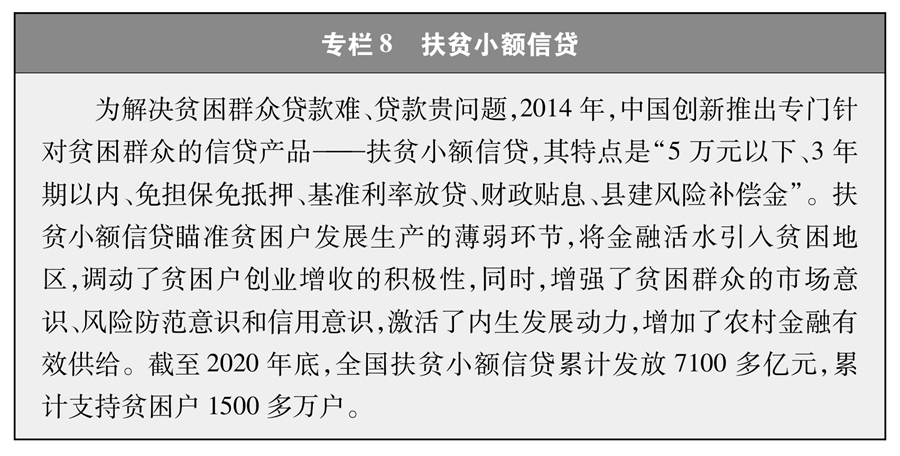
Relocation and poverty alleviation. For poor people who live in areas with harsh natural environment, poor living conditions and frequent natural disasters, it is difficult to get rid of poverty on the spot, and implement ex situ poverty alleviation and relocation (Box 9). Fully respect the wishes of the masses, adhere to the principles of meeting conditions and voluntary participation of the masses, strengthen ideological guidance, and refrain from coercion. Comprehensively arrange the relocation targets, carefully formulate the relocation plan, reasonably determine the relocation scale, and implement it in a planned and step-by-step manner. More than 9.6 million poor people living in areas where "one side of the soil and water can’t support one side" have been lifted out of poverty through relocation. Reclamation and greening will be carried out on the relocated old house base to improve the ecological environment of the relocation area. Strengthen the construction of supporting facilities for resettlement sites, industrial parks and poverty alleviation workshops, actively create employment opportunities for the relocated population, ensure that they have a stable income, enjoy the same basic public services as the local people, and ensure that they can move out, live steadily and gradually become rich.

Ecological compensation to get rid of poverty. Practice the concept of "Lucid waters and lush mountains are invaluable assets", pay equal attention to tackling poverty and ecological protection, increase the transfer payment for key ecological functional areas while strengthening the ecological protection and restoration in poverty-stricken areas, and continuously expand the scope of policy implementation, so that poor people who have the ability to work can be turned into ecological protection personnel such as forest guards on the spot. Since 2013, 74.5 million mu of farmland has been returned to forests and grasslands in poverty-stricken areas, more than 1.1 million poor people have been selected as ecological rangers, and 23,000 specialized cooperatives (teams) for poverty alleviation and afforestation have been established. Poverty-stricken people actively participate in the construction of ecological projects such as land greening, returning farmland to forests and grasslands, and the protection and restoration of forests, grasslands, wetlands and other ecosystems, and develop economic forest planting such as woody oil and forest tourism, which not only broadens the channels for increasing income, but also significantly improves the ecological environment in poverty-stricken areas, achieving a "win-win".
Develop education to get rid of poverty. Adhere to the education that no matter how poor you are, no matter how poor you are, no matter how poor you are, strengthen education to help the poor, prevent children from losing at the starting line, strive to give every child a chance to shine in life, and block the intergenerational transmission of poverty (Box 10). We will continue to improve the ability to guarantee schools, degrees, teachers and financial aid in poverty-stricken areas, and more than 200,000 students from poor families who dropped out of compulsory education will all return to school to study, thus ensuring the full realization of compulsory education for school-age children. We will implement preferential policies such as targeted enrollment, student employment, and vocational education to help more than 8 million junior and senior high school graduates from poor families receive vocational education and training, 5.14 million students from poor families receive higher education, and key universities will recruit more than 700,000 students from rural and poverty-stricken areas, broadening the vertical flow channels for poor students. Training in the national common language for rural teachers and young and middle-aged farmers and herdsmen in ethnic minority areas was carried out, with a total training of more than 3.5 million person-times, so as to enhance the employability of poor people in ethnic minority areas. The "Learn Putonghua before School" campaign has been piloted in Liangshan Yi Autonomous Prefecture, Sichuan Province, Mabian Yi Autonomous County, Ebian Yi Autonomous County and Jinkouhe District of Leshan City, covering 430,000 preschool children and helping them learn Putonghua.

Social security covers a lot. Focus on special poor groups and implement the bottom-up security policy. The implementation of the renovation and upgrading project of the service facilities for the poor people has significantly enhanced the ability of centralized support. The rural subsistence allowance system is effectively linked with the poverty alleviation policy, and the national rural subsistence allowance standard has increased from 2068 yuan per person per year in 2012 to 5962 yuan in 2020, an increase of 188.3%. The poverty alleviation department and the civil affairs department regularly carry out data comparison and verification, so as to realize the "all-in-one insurance" for the poor.
China has also taken other multi-channel and diversified poverty alleviation measures in light of actual conditions and local conditions. Vigorously promote employment and poverty alleviation, and support the poor people who have the ability to work locally or go out to work and start businesses through free vocational skills training, the export of labor services for poverty alleviation cooperation between the east and the west, the absorption of poverty alleviation workshops and leading enterprises, the promotion of returning home to start businesses, and the placement of poverty alleviation public welfare posts. The scale of poor labor has increased from 12.27 million in 2015 to 32.43 million in 2020. Carry out health poverty alleviation projects, take health poverty alleviation as an important measure to overcome poverty and prevent poverty from returning to poverty due to illness (Box 11). In-depth implementation of the network poverty alleviation project, support poor areas, especially deep poverty areas such as "three districts and three States", improve network coverage, and promote the "internet plus" poverty alleviation model. We will implement asset income to help the poor, invest the special poverty alleviation funds of the central government and other agriculture-related funds into assets formed by facilities agriculture, photovoltaic, rural tourism and other projects, and convert them into shares to quantify them in poor villages, so as to promote industrial development, increase people’s income and solve the problem of village collective economic income. After the outbreak of the COVID-19 epidemic in 2020, China adopted a series of measures to help the epidemic, increased employment stability, and launched consumption poverty alleviation actions, effectively overcoming the impact of the COVID-19 epidemic.

(four) strict standards, orderly exit, to solve the problem of "how to retreat".
Establish a poverty exit mechanism, and clarify the criteria and procedures for the exit of poor counties, poor villages and poor people, so as to prevent "being out of poverty" such as digital poverty alleviation and false poverty alleviation, and "not retreating" such as meeting the standards and unwilling to quit. Formulate a poverty alleviation plan and an annual poverty reduction plan to ensure a standardized, reasonable and orderly exit. Strictly implement the exit criteria, strictly standardize the work flow, implement democratic appraisal for poor people, audit and review for poor villages and counties, make public announcements of exit results, and let the masses participate in the evaluation, so as to make the procedures open, the data accurate, the files complete and the results fair. Strengthen supervision and inspection, entrust a third party to make a special assessment of Tuomao County and the poverty-stricken population every year, focusing on the remote areas with poor conditions and weak foundation, focusing on the assessment of the exit accuracy of the poverty-stricken population, the incidence of poverty in Tuomao County, and the satisfaction of the masses to ensure that the exit results are true. From 2020 to the beginning of 2021, a national survey on poverty alleviation will be carried out to comprehensively and accurately find out the realization of poverty alleviation for the poor. After the poor population, poor villages and poor counties withdraw, the original support policies will remain unchanged for a certain period of time, with no responsibility, no help, no policy and no supervision, leaving a buffer period to ensure stable poverty alleviation.
(5) Follow-up monitoring, prevent returning to poverty, and solve the problem of "how to stabilize"
Stable poverty alleviation and not returning to poverty is the real poverty alleviation. For poverty-stricken counties, a five-year transition period will be set up from the date of poverty alleviation. During the transition period, the main assistance policies will remain generally stable, and the existing assistance policies will be optimized and adjusted item by item, and gradually the resources will be concentrated to support poverty alleviation and comprehensively promote rural revitalization. We will improve the dynamic monitoring and assistance mechanism to prevent poverty, and carry out regular inspections and dynamic management for unstable households out of poverty, marginal households prone to poverty, and households with serious difficulties in their basic lives due to rigid expenditures such as accidents due to causes and disasters, so as to achieve early detection, early intervention and early assistance to prevent poverty from returning and creating new poverty. Continue to support the development of rural characteristic industries in poverty-stricken areas and continue to promote the stable employment of poverty-stricken people. Do a good job in follow-up support for relocation, promote employment through multiple channels, strengthen social management, promote social integration, and ensure that the relocated people are stable, have jobs, and gradually become rich. Adhere to and improve the system of the first secretary and task force in the village, cooperation between the east and the west, counterpart support and social assistance. Continue to strengthen the support of the will and wisdom, and encourage and guide the people out of poverty to live a better life by their own efforts. Carry out post-evaluation work to consolidate the results of poverty alleviation, compact the responsibilities of party committees and governments at all levels, and resolutely hold the bottom line of not returning to poverty on a large scale.
The precise poverty alleviation strategy is a magic weapon for China to win the battle against poverty, and it is a major innovation in China’s poverty reduction theory and practice. It embodies all the scientific attitudes of the Communist Party of China (CPC) to proceed from reality and follow the law of development of things, the innovative courage to boldly rush and try in the face of new contradictions and new problems, the unremitting exploration of communist party’s ruling law, the law of socialist construction and the law of human social development, and the lofty pursuit of realizing the all-round development of people and the common prosperity of all people. The precise poverty alleviation strategy not only ensures the overall victory in tackling poverty, but also effectively improves the modernization level of the national governance system and governance capacity, and enriches and develops the Communist Party of China (CPC)’s ruling philosophy and strategy in the new era.
Fourth, explore new paths for human poverty reduction
Poverty eradication is a global problem. Different countries have different national conditions and different stages of development, so do poverty reduction standards, ways and means. China’s poverty reduction is based on its own national conditions, profoundly grasps the poverty characteristics and poverty governance laws of China, adheres to the leadership of the Communist Party of China (CPC), adheres to the people-centered development thought, adheres to the political advantage of China’s socialist system to concentrate on doing great things, adheres to the precise poverty alleviation strategy, persists in mobilizing the enthusiasm, initiative and creativity of the broad masses of poor people, persists in carrying forward the virtues of working together, uniting and helping each other, persists in seeking truth and being pragmatic, and has developed a poverty reduction road with China characteristics, forming an anti-poverty theory with China characteristics. China’s valuable experience in the practice of poverty reduction belongs to both China and the world, which expands the anti-poverty thinking of human beings and explores a new path for human poverty reduction.
(A) adhere to the people as the center
The Communist Party of China (CPC) is a political party with great ambitions. The Communist Party of China (CPC)’s goal is both grand and simple. In the final analysis, it is to make all the people live a good life. Over the past 100 years, no matter how the international and domestic situation changes, the Communist Party of China (CPC) has always put the people at the top of its mind, always adhered to its initial mission of seeking happiness for the people and rejuvenation for the nation, and United and led the people to fight poverty with unshakable faith and will. In the new era, the Communist Party of China (CPC) adheres to the people-centered development thought, adopts a series of unconventional policy measures to push forward poverty alleviation, and strives to make the poor people have better income, better education, better medical and health services and better living conditions. Taking the satisfaction of the masses as an important measure to measure the effectiveness of poverty alleviation, and concentrating on solving the basic livelihood needs of the poor, it is better to have fewer major projects and give priority to ensuring capital investment in poverty alleviation; It is better to sacrifice some current interests and local interests, but also to obey and serve the overall situation of poverty reduction; It is better to slow down the economic growth, but also to ensure that the goal of poverty alleviation is completed as scheduled. On the battlefield where there is no smoke, the vast number of party member and cadres go to the mission with blood, keep their promises with actions, and exchange their hard work for the happiness of the poor people. The first secretary and team members in the village took root in the front line and worked hard. The grassroots cadres in party member worked hard and worked hard, and the volunteers devoted themselves wholeheartedly. Some of them have been fighting for a long time in the front line of poverty alleviation, giving up their families for everyone and making great sacrifices; Some run around for the masses to get rid of poverty, climb mountains and take risks, and work tirelessly;Some work overtime all the year round and break down from constant overwork; Some people are injured in poverty alleviation work, but they still persist in their work despite illness. Since poverty alleviation, more than 1,800 party member and cadres have given their precious lives to the cause of poverty reduction, and practiced their vows of sacrificing everything for the people with practical actions. The practice of tackling poverty in the new era profoundly interprets the people-centered concept, which is the most concentrated, full and vivid embodiment of the Communist Party of China (CPC)’s purpose of serving the people wholeheartedly in the new era.
The practice of poverty reduction in China shows that poverty is essentially a fundamental attitude towards the people, and people-centered is the fundamental driving force for poverty alleviation. Only by truly putting the people in mind and putting people’s interests first can we truly understand poverty, help the poor and get rid of poverty, and there will be inexhaustible motivation, clear direction and good methods to reduce poverty.
(2) Put poverty reduction in a prominent position in governing the country.
Poor development conditions in poverty-stricken areas and poor people’s self-development ability are weak. It is far from enough to rely on individual, regional and folk forces to eliminate poverty. It must be the responsibility of the ruling party and the state and be promoted to national will, national strategy and national action. The Communist Party of China (CPC) has always regarded poverty eradication as an important task for national security, formulated and implemented the Party’s line, principles and policies for a certain period, and put forward proposals for national medium-and long-term development planning, all of which regard poverty reduction as an important content, deployed at the national level, and promoted by using national strength. Generations of the Communist Party of China (CPC) people, anchored to a goal, stubble after stubble. Since the 18th National Congress of the Communist Party of China, the Communist Party of China (CPC) has placed poverty alleviation in a prominent position in governing the country, strengthened the centralized and unified leadership of the Party, and made overall plans and vigorously promoted it. From the leaders of the Party to the broad masses of cadres in party member, the whole Party has the same goal and the same heart. Strengthen top-level design and strategic planning, formulate and issue policy documents such as "Decision on Winning the Fight against Poverty" and "Guiding Opinions on Winning the Fight against Poverty for Three Years", clarify the objectives, paths and specific measures and stick to them consistently. Finance at all levels has continuously increased investment (Figure 4), and established a diversified capital investment system (Box 12) to provide financial guarantee for the development of poverty reduction. Give full play to the advantages of the socialist system in concentrating on doing great things, and widely mobilize all forces to actively participate. The establishment of the responsibility system, policy system, organization system, investment system, mobilization system, supervision system, assessment system and other institutional systems has provided strong support for the smooth progress of poverty alleviation.
The practice of poverty reduction in China shows that the way to govern the country begins with enriching the people; The wealth of the people is the responsibility of the country. Poverty reduction is a pioneering and arduous task. To achieve the goal of poverty reduction, the feelings, will and determination of leaders are crucial. It is essential for the ruling party and the state to shoulder their responsibilities to the people, play a leading role, and gather all forces. It is essential to maintain the continuity and stability of policies.
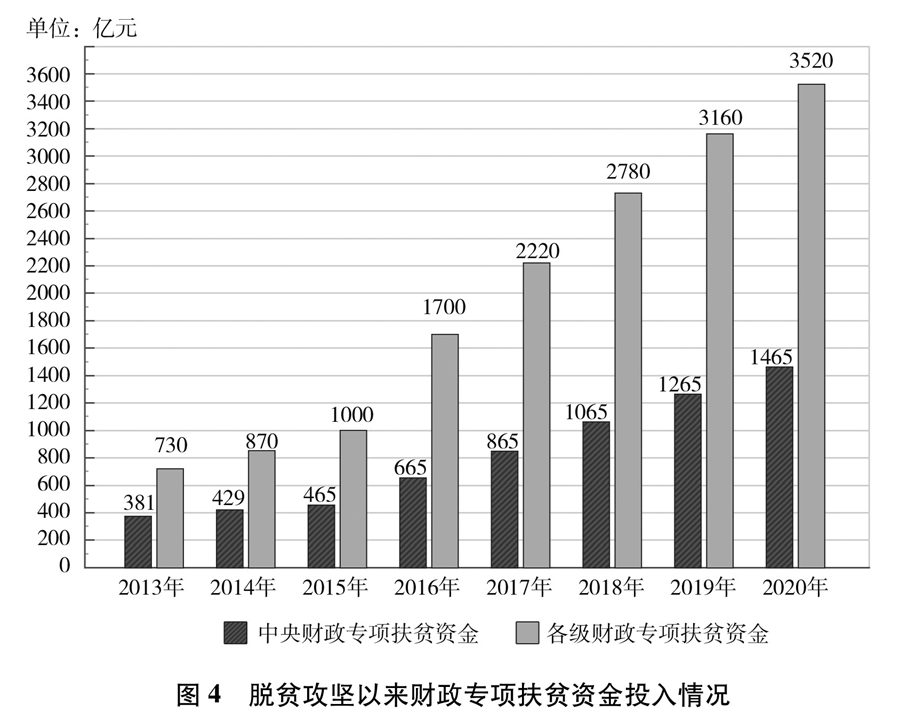

(3) Eliminating poverty through development.
Poverty is, in the final analysis, a development problem. As the largest developing country in the world with a population of 1.4 billion, development is the key to solving all problems in China, including poverty. The Communist Party of China (CPC) has always regarded development as the top priority in governing and rejuvenating the country, concentrated on construction and development, solved the problem of insufficient imbalance through development, and created a miracle of rapid economic development and long-term social stability. Take reform as an important driving force to eradicate poverty, from land reform and the establishment of a socialist system after the founding of New China, to the implementation of the household contract responsibility system after the reform and opening up, to the establishment of a socialist market economic system and the complete exemption of agricultural taxes, and then to the implementation of the "separation of the three powers" of rural contracted land ownership, contracting rights and management rights and the promotion of the reform of rural collective property rights system since the 18th National Congress of the Communist Party of China, so as to continuously eliminate the institutional and structural factors leading to poverty, and continuously promote rural development and increase farmers’ income. Actively conform to the trend of globalization, unswervingly expand opening to the outside world, and foreign trade continues to grow rapidly, creating a large number of jobs for the vast rural labor force and broadening the channels for increasing income. Since the founding of New China, especially since the reform and opening-up, China’s economy and society have developed rapidly, its economic aggregate has been constantly rising, and its comprehensive strength has been significantly improved, which has not only formed a strong driving effect on poverty alleviation, but also laid a solid foundation and provided a strong guarantee for large-scale poverty alleviation and development.
The practice of poverty reduction in China shows that development is the most effective way to eliminate poverty and the most stable way to create a happy life. Only development can provide a scientific path and lasting motivation for economic and social development and improvement of people’s livelihood; Only development can better protect people’s basic rights; Only development can continuously satisfy the people’s eager yearning for a better life.
(D) Promoting the process of poverty reduction based on reality
Poverty has diversity and complexity, and the causes of poverty are also different and pluralistic. Based on the national conditions of China, according to the different stages of development and the level of economic and social development, and according to the changes in the scale, distribution and structure of the poor population, the standards, objectives and strategies for poverty reduction are scientifically formulated, and the concepts, methods and means for poverty reduction are constantly innovated, step by step, with sustained efforts. After the founding of New China, poverty was mainly alleviated through social system reform and large-scale socialist construction. Since the reform and opening-up, poverty reduction has been mainly driven by rural economic system reform and economic growth, with emphasis on the development-oriented poverty alleviation policy, guiding poor areas and poor people to take the market as the guide, adjusting the economic structure, developing local resources, developing commodity production, and improving their self-accumulation and self-development capabilities. In the new era, while continuing to adhere to the development-oriented poverty alleviation, we will implement the precise poverty alleviation strategy. The poverty alleviation path will be changed from "flood irrigation" to "precise drip irrigation", the resource use mode will be changed from multi-head dispersion to overall concentration, the poverty alleviation mode will be changed from "blood transfusion" to "hematopoiesis", and the evaluation system will be changed from focusing on regional GDP to focusing on poverty alleviation results. According to the reality of economic and social development and the promotion of poverty reduction, China has gradually adjusted and raised the poverty alleviation standards, so that more and better development results can benefit the people.
The practice of poverty reduction in China shows that the occurrence and evolution of poverty has its own characteristics and laws. Poverty control must proceed from reality, scientifically judge the bottleneck factors that restrict poverty reduction and development, find the breakthrough point to release the power of poverty reduction, constantly adjust and innovate the strategies and policy tools for poverty reduction according to local conditions, and improve the efficiency of poverty control.
(5) Give full play to the main role of the poor.
Poor people are the main body of getting rid of poverty and getting rich. Poverty alleviation should not only rely on external forces, but also stimulate internal forces in order to form a joint force. China fully respects and actively exerts the main role of the poor people, stimulates and cultivates their endogenous motivation, and enhances their ability to participate in development, share development and develop independently, so that the poor people will not only become beneficiaries of poverty reduction, but also become contributors to development. Adhere to the combination of poverty alleviation and supporting the will and wisdom, so as to enrich the pockets and brains, and let the poor people have both the idea and the way to get rid of poverty. Relying on farmers’ night schools and new era workshops, we will strengthen education and training to enhance the basic skills of poor people in developing production and doing business. Improve poverty alleviation methods, establish an effective mechanism of positive incentives and catching up with learning, and use more ways such as production awards, labor subsidies, and work-based relief to encourage poor people to rely on labor to create happiness. Vigorously publicize the advanced models of self-improvement and poverty alleviation, extensively carry out lively and diverse publicity and education, guide the poor people to establish the concept of "preferring hard work rather than suffering", and change the face of poverty and backwardness with both hands.
The practice of poverty reduction in China shows that the people are the creators and promoters of history and the true heroes with indomitable spirit. As long as we adhere to the endogenous motivation of serving the people, relying on the people, respecting the people’s dominant position and pioneering spirit, and encouraging the poor people to work hard and strive hard, we will certainly be able to overcome poverty.
(6) Gather the strength of all parties to form a strong joint force.
Poverty alleviation is an arduous and complicated systematic project, which needs to mobilize all parties to actively participate. In order to win the battle against poverty, the Communist Party of China (CPC) relies on a strict organizational system and an efficient operation mechanism to mobilize and rally the forces of all parties extensively and effectively, to build a large-scale poverty alleviation pattern in which the government, society and market work together, special poverty alleviation, industry poverty alleviation and social poverty alleviation complement each other, and to form a multi-subject social poverty alleviation system with cross-regional, cross-departmental and cross-unit participation and the whole society. Strengthen poverty alleviation cooperation and counterpart support between the east and the west (Box 13), promote assistance at all levels in provinces, cities and counties, promote the flow of talents, capital and technology to poor areas, realize complementary advantages and narrow regional gaps. Actively carry out designated poverty alleviation, and organize party and government organs, people’s organizations, state-owned enterprises and institutions and the army at all levels to help poor counties or poor villages (Box 14). All democratic parties, federations of industry and commerce and personages without party affiliation give full play to their respective advantages and make intellectual contributions to winning the battle against poverty. Actively promote all walks of life to give full play to their professional advantages and carry out poverty alleviation through industry, science and technology, education, culture, health and consumption. Widely mobilize private enterprises to participate in poverty alleviation and development, and guide subjects with strong market development ability to enter areas with great resource development potential to achieve mutual benefit and common development (Box 15). Widely mobilize social organizations and individual citizens to actively participate in poverty alleviation and carry out poverty alleviation public welfare activities. The establishment of the National Poverty Alleviation Day, the establishment of a national honor system for tackling poverty, and the recognition of advanced models for tackling poverty have created an atmosphere of social assistance that everyone is willing to do, everyone can do, and everyone can do.
The practice of poverty reduction in China shows that only by mobilizing and rallying all forces, guiding the whole society to care for the poor people, care about the cause of poverty reduction, join in the action of poverty alleviation, form a common will and act together, and work together to overcome difficulties, can we finally overcome the stubborn disease of poverty.


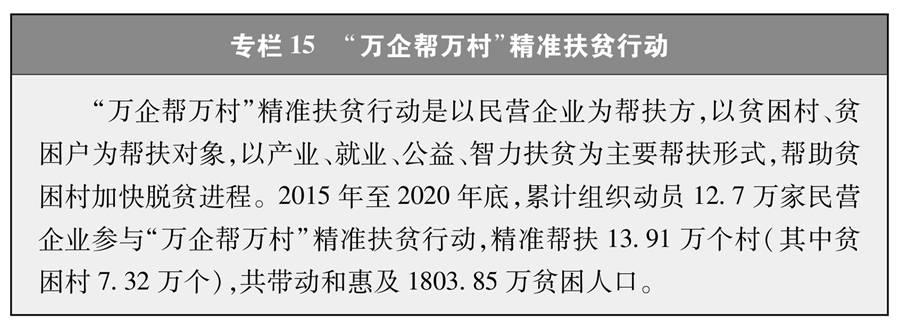
The road to poverty reduction with China characteristics is a successful road pioneered by Chinese people under the leadership of the Communist Party of China (CPC) after a long and arduous exploration. China’s successful practice and valuable experience in eliminating absolute poverty have deepened the understanding of the law of human poverty reduction, enriched and developed the theory of human anti-poverty, boosted the confidence of all countries, especially the vast number of developing countries, provided reference for other countries to choose their own development path of poverty reduction, and provided China’s plan for solving the problems of modern state governance and opening up brighter prospects for the development of human society.
5. Work together to build a community of human destiny for common development without poverty.
If the world is good, China can be good; China is good, and the world is better. China has always closely linked its own destiny with the destiny of people all over the world. While devoting itself to eradicating its own poverty, it has actively participated in international poverty reduction cooperation, been an advocate, promoter and contributor to the international poverty reduction cause, and worked hand in hand with other countries to build a community of human destiny without poverty and common development.
(A) China’s poverty reduction and development accelerate the global poverty reduction process.
In the past 100 years, under the leadership of the Communist Party of China, the people of China have turned over and liberated to solve the problem of food and clothing, and from a basic well-off society to an all-round well-off society. China has made great contributions to human anti-poverty with his own development. Since the reform and opening up, according to the current poverty standards, 770 million rural poor people in China have been lifted out of poverty; According to international poverty line standard of the World Bank, the poverty reduction population in China accounted for more than 70% of the global poverty reduction population in the same period. Against the background that the global poverty situation is still grim and the polarization between the rich and the poor is intensifying in some countries, China won the battle against poverty, achieved the poverty reduction goal of the United Nations Agenda for Sustainable Development in 2030 10 years ahead of schedule, significantly reduced the territory of the world’s poor population, and "made an important contribution to the realization of a better and more prosperous world described in the Agenda for Sustainable Development in 2030". As the largest developing country in the world, China has achieved the synchronization of rapid development and large-scale poverty reduction, economic transformation and the elimination of absolute poverty, fully accomplished the goal and task of poverty alleviation as scheduled, greatly accelerated the global poverty reduction process, and wrote a new chapter in the history of human anti-poverty.
(2) The international community provides support and assistance to China in poverty reduction.
After the founding of New China, efforts were made to break the external blockade, actively carry out foreign exchanges and cooperation, and win the support of the international community. Since the reform and opening up, China has carried out extensive cooperation with the United Nations development system and the World Bank in the field of poverty alleviation. At the same time, it has received assistance from some developed countries and implemented poverty alleviation cooperation projects. It has not only received support in terms of capital investment, knowledge transfer and technical assistance, but also learned from the advanced poverty alleviation concepts and methods of the international community, which has promoted the development of poverty alleviation in China. China has successively cooperated with the United Nations Development Programme, the World Bank and other international institutions and organizations to implement foreign-funded poverty alleviation projects in some poverty-stricken counties, and introduced various preferential loans and free assistance. The international poverty reduction exchange and cooperation project has alleviated the poverty level of the poor people in the project area, promoted the system innovation and management level of poverty reduction in China, and laid the foundation for the sustainable development of the project area. The people of China will always remember their valuable support and help to the international community. The Chinese nation is grateful and reciprocates, and China has always provided support to other countries for poverty reduction and development within its capacity.
(C) China actively carried out international exchanges and cooperation in poverty reduction.
China actively participates in global poverty governance, continuously deepens exchanges and cooperation in the field of poverty reduction, and promotes the establishment of a new international poverty reduction exchange and cooperation relationship with mutual respect and win-win cooperation as the core, so as to jointly enhance the well-being of people of all countries.
Support the poverty reduction and development of developing countries. Since the founding of the People’s Republic of China, China has provided assistance to the countries concerned under the situation that the country has a lot to do and financial resources are tight, which has provided support for developing countries to strive for national independence and liberation and promote economic and social development. After the reform and opening up, China’s foreign aid has become richer in content and more diverse in forms, which has promoted the common development of China and other developing countries. In the new era, China shoulders the responsibility of a big country, promotes the transformation and upgrading of foreign aid to international development cooperation, puts forward China’s plan, contributes China’s wisdom and injects China’s strength to solve global development problems and implement the UN’s 2030 sustainable development agenda. The Chairman of the Supreme Leader announced on several major international occasions that a series of practical measures for China to carry out international development cooperation have been implemented on schedule or are being promoted in an orderly manner (Box 16). China initiated the "One Belt, One Road" initiative, promoted regional economic and social development cooperation on a larger scale, at a higher level and at a deeper level, and supported relevant countries to better achieve poverty reduction and development. According to the World Bank research report, the joint construction of the Belt and Road Initiative will lift 7.6 million people out of extreme poverty and 32 million people out of moderate poverty in relevant countries. Since the founding of the People’s Republic of China more than 70 years ago, China has provided various forms of assistance to more than 160 countries and international organizations in Asia, Africa, Latin America and the Caribbean, Oceania and Europe, reduced or exempted the debts of the countries concerned, and helped developing countries to implement the Millennium Development Goals.

Implement international poverty reduction cooperation projects that benefit people’s livelihood. In Asia, China and ASEAN countries jointly launched the rural poverty reduction promotion plan, and implemented the "Demonstration and Cooperation Technical Assistance Project for Poverty Reduction in East Asia" in rural grass-roots communities in Laos, Cambodia and Myanmar (Box 17). In Africa, China has built water conservancy infrastructure, vocational and technical schools, social security housing and other facilities for African countries, built an agricultural cooperation demonstration zone, and promoted the implementation of China-Africa technical cooperation on fungi and grass, the construction of China-Africa friendship hospitals, and the construction of the headquarters of the African CDC (Box 18). In the South Pacific, China has promoted the implementation of free aid and preferential loans to Pacific island countries, and carried out infrastructure construction and technical cooperation and assistance projects in agriculture and medical care. In Latin America, agricultural technology demonstration centers will be built to help local people in recipient countries get rid of poverty. China has also cooperated with UNESCO to set up international rural education research and training centers and other institutions to implement rural education transformation and teacher training projects for countries such as Africa and Southeast Asia.
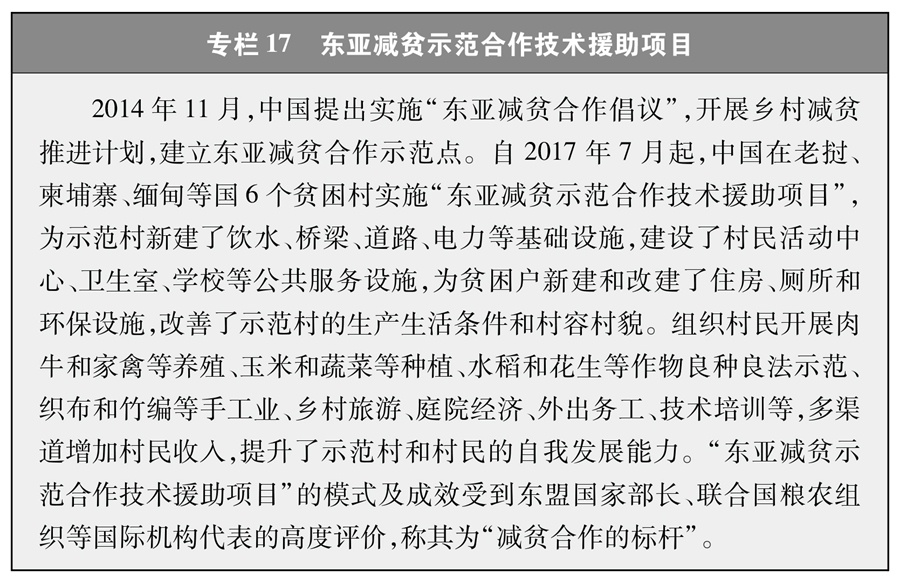

Share and exchange experiences in poverty reduction. Through building platforms, organizing training, think tank exchanges and other forms, we will carry out poverty reduction exchanges and share poverty reduction experiences. On the International Day for the Eradication of Poverty, China and the United Nations agencies in China jointly held a high-level forum on poverty reduction and development. China initiated the China-ASEAN Forum on Social Development and Poverty Reduction, the International Forum on Human Poverty Reduction Experience, and held a series of discussion and exchange activities such as the China-Africa Conference on Poverty Reduction and Development, the International Symposium on "Getting rid of Poverty and the Responsibility of Political Parties", and the International Forum on Reform and Opening-up and Poverty Alleviation in China. Cooperate with the ASEAN Secretariat and relevant ASEAN countries to implement the "ASEAN+China, Japan and Korea Village Officials Exchange Project" for grassroots village officials (community officials). Cooperate with relevant countries and regional organizations to carry out international poverty reduction training. Since 2012, more than 130 international poverty reduction training courses have been held, and officials from 116 countries (organizations) have participated in the training.
Today, the world is in a great change that has never happened in a century. The COVID-19 epidemic is still spreading all over the world. Poverty, hunger and disease are eroding people’s hopes and confidence in pursuing a better life. What kind of world to build and where human civilization will go are related to the future and destiny of every country and everyone. Everyone has the right to a good life. All countries should shoulder their responsibilities to the people, actively promote poverty reduction and development, let the sunshine of fairness and justice break through the haze of poverty and backwardness, and light up a bright future of prosperity and development. China is willing to strengthen exchanges and cooperation with other countries in poverty reduction, work together to promote the international poverty reduction process, and make greater contributions to building a community of human destiny without poverty and common development.
Concluding remarks
China won the battle against poverty and achieved the goal and task of fighting poverty as scheduled. The people of China have taken a solid step on the road of creating a better life and achieving common prosperity. At the same time, China is still the largest developing country in the world, and it still faces the contradiction between people’s growing needs for a better life and unbalanced development. There is still a long way to go to solve the problem of insufficient development imbalance, narrow the regional development gap between urban and rural areas, and realize the all-round development of people and the common prosperity of all people.
Getting rid of poverty is not the end, but the starting point of a new life and a new struggle. The Communist Party of China (CPC) will always adhere to the initial intention and mission of seeking happiness for the people and rejuvenation for the nation, always put the people in the highest position, and make unremitting efforts to realize the all-round development of people and the common prosperity of all people, constantly improve people’s well-being, better meet people’s new expectations for a better life, and let all people live a better life.
If the nation is to be revived, the countryside will be revitalized. After winning the fight against poverty, China will continue to consolidate and expand the achievements of tackling poverty, make effective connection with rural revitalization, and realize the historic shift of the focus of the work on agriculture, rural areas and farmers. China will base itself on the new development stage, implement the new development concept, build a new development pattern, give top priority to solving the "three rural issues", adhere to the priority development of agriculture and rural areas, take the road of rural revitalization in Socialism with Chinese characteristics, and comprehensively promote rural revitalization with more powerful measures and more powerful forces.
By 2035, China will basically realize socialist modernization, make decisive progress in rural revitalization, and basically realize agricultural and rural modernization. At that time, in rural China, the agricultural structure was fundamentally improved, the quality of farmers’ employment was significantly improved, relative poverty was further alleviated, and common prosperity took solid steps; The equalization of basic public services in urban and rural areas has basically been realized, and the system and mechanism of urban-rural integration development have been improved; Rural civilization has reached a new height, and the rural governance system is more perfect; The rural ecological environment has fundamentally improved, and beautiful and livable villages have basically been realized.
By 2050, China will be built into a powerful socialist modernization country in an all-round way, achieve the goal of the second century, and revitalize the countryside in an all-round way. At that time, the rural areas of China were strong in agriculture, beautiful in rural areas and rich in farmers, with all-round economic and social progress and prosperous development of various undertakings. At that time, the common prosperity of all the people in China was basically realized, the people in China enjoyed a happier and healthier life, and China continued to advance towards the higher goal of realizing all-round development of people and common prosperity of all the people.
The development of China cannot be separated from the world, and the development of the world cannot be separated from China. China has always closely linked its own development with human development, and has always been a builder of world peace, a contributor to global development and a defender of the international order. The prosperous future of China will be a more open and inclusive China, a more benign interaction with the world in China, and a greater contribution to building a better world in China.
Appendix Changes and Adjustment of Poverty Alleviation Standards in China
Determining poverty alleviation standards according to the level of national economic and social development and the basic living needs of the poor population has been the practice of China since it implemented large-scale, planned and organized poverty alleviation.
China first formulated the poverty alleviation standard in 1986, which was 206 yuan, and the corresponding number of poor people was 125 million, mainly to solve the problem of food and clothing. In 2001, when the first ten-year rural poverty alleviation and development program was formulated, the poverty alleviation standard was raised to 865 yuan, and the corresponding number of poor people was 94.228 million. In 2011, when the outline of rural poverty alleviation and development in the second decade was formulated, the poverty alleviation standard was raised to 2,300 yuan (at constant prices in 2010), and the corresponding number of poor people was 122 million.
Since poverty alleviation, the poverty-stricken population in China has been identified and withdrawn by households, and the main measure is "one income" and "two worries and three guarantees". "One income" means that the annual per capita net income of the household has steadily exceeded the current national poverty alleviation standards, and "two guarantees and three guarantees" means that people have no worries about food and clothing, compulsory education, basic medical care and housing security are guaranteed. China’s poverty-stricken population exit standard is a comprehensive multi-dimensional standard, which not only measures the income level, but also considers the realization degree of the poverty-stricken population’s right to subsistence and development, which embodies the reality of China’s economic and social development and the basic requirements for building a well-off society in an all-round way.
(1) The Outline of National Agricultural Development from 1956 to 1967 clearly states that agricultural cooperatives should give proper care to widowed and lonely members who lack labor force and have no dependence on their lives, so as to ensure food, clothing, burning (fuel), education (children and teenagers) and burial, so that they can rely on them.
② The 13th National Congress of the Communist Party of China proposed that after the Third Plenary Session of the 11th CPC Central Committee, the strategic deployment of China’s economic construction will be divided into three steps. The first step is to double the GNP of 1980 and solve the problem of food and clothing for the people. The second step is to double the gross national product by the end of the 20th century, so that people can live a well-off life. Third, by the middle of the 21st century, the per capita gross national product will reach the level of moderately developed countries, and the people will be well-off and basically realize modernization.
(3) In 1988, Comrade Deng Xiaoping clearly pointed out: "The coastal areas should speed up opening up to the outside world, so that this vast area with a population of 200 million can develop quickly first, thus promoting the better development of the mainland. This is a problem that concerns the overall situation. The mainland should take care of the overall situation. On the other hand, when it reaches a certain stage, it requires the coastal areas to put more efforts to help the development of the mainland, which is also an overall situation. At that time, the coast should also obey this overall situation. " Source: Selected Works of Deng Xiaoping, Volume III.
(4) "Three Wests" refers to Hexi area in Gansu Province, Dingxi area and Xihaigu area in Ningxia Hui Autonomous Region, which is one of the most difficult areas in China in the early days of reform and opening up. In December, 1982, China started to implement the "Three Wests" agricultural construction, involving 47 counties (cities, districts) (expanded to 57 in 1992). The agricultural construction of "Three Wests" has a pioneering, leading and exemplary significance in the course of poverty alleviation and development in China. It has successfully explored the aspects of reforming simple relief poverty alleviation into development poverty alleviation, concentrating on the implementation of district development, relocating poverty alleviation, and combining poverty alleviation and development with ecological construction, which has had a far-reaching impact on the large-scale, planned and organized poverty alleviation and development nationwide since 1986.
⑤ The 15th National Congress of the Communist Party of China put forward a new "three-step" development strategy, namely, to double the gross national product in 2000 in the first decade of the new century, to make the people’s well-off life richer and to form a relatively perfect socialist market economic system; After 10 years of hard work, by the time the Communist Party of China (CPC) is 100 years old, the national economy will be more developed and various systems will be more perfect; By the middle of the next century, when People’s Republic of China (PRC) is 100 years old, it will basically realize modernization and build a prosperous, strong, democratic and civilized socialist country.
⑥ "two guarantees and three guarantees" refers to the stable realization of food and clothing, and the guarantee of compulsory education, basic medical care and housing safety.
⑦ "Zhiguo Ethnic Group" is a specific title for some ethnic groups in Yunnan Province, which originated from the fact that these ethnic groups directly entered the socialist society during the period of democratic reform, spanning one or several stages of development.
(8) The general survey of poverty alleviation is an important basic work of precision poverty alleviation and a comprehensive test of the effectiveness of poverty alleviation. From 2020 to 2021, China carried out a national survey of poverty alleviation in 22 provinces in the central and western regions, focusing on the authenticity and accuracy of poverty alleviation results, and comprehensively understanding the realization of poverty alleviation in poverty-stricken counties in the country. The contents of the census include the basic situation of establishing a card, the realization of "two guarantees and three guarantees", the assistance and participation in poverty alleviation projects, and the basic public services in counties and administrative villages.
Pet-name ruby "Three Districts" refers to Xizang Autonomous Region, Xinjiang Uygur Autonomous Region and Tibet-related counties in Sichuan, Yunnan, Gansu and Qinghai provinces. "Three States" refer to Liangshan Yi Autonomous Prefecture in Sichuan Province, Lisu Autonomous Prefecture in Nujiang, Yunnan Province and Linxia Hui Autonomous Prefecture in Gansu Province.
Attending "four discussions and two publicity" refers to the basic working procedure of democratic decision-making on village affairs under the leadership of village party organizations. "Four discussions" refers to the proposal of the Party branch meeting, the deliberation of the village "two committees", the deliberation of general party membership meeting, the villagers’ representative meeting or the resolution of the villagers’ meeting; "Two publicity" refers to the publicity of resolutions and implementation results.
In February 2021, China announced the elimination of absolute poverty. UN Secretary-General Guterres sent a letter to the Chairman of the Supreme Leader, saying that "this great achievement has made an important contribution to the realization of a better and more prosperous world as described in the 2030 Agenda for Sustainable Development" and that "China’s extraordinary achievements have brought hope and provided encouragement to the entire international community".



